Attractions
- UNESCO World Heritage Sites
- Protected Areas
- Eight Thousanders
- Pilgrimage Sites
- Bungee Jumping
- Motor Biking
- Rafting & Kayaking
- Mountain Biking
- Paragliding
- Cave Exploration
- Bird Watching
- Mountain Viewing
- Jungle Discovery
- Butterfly Watching
- Nagarkot Sunrise and Sunset
- Traditional Crafts
- Meet the People
- Village Tours
- Food & Culinary
- Cultural Tours
- Heritage Walk
- Museum Tours
- Faith Healing
- Panchakarma Treatment
- Sound Meditation
- Natural Hot Water Springs in Nepal
- Pilgrimage Tours
- Destination Wedding
- Indra Jatra
- Chhat Parva
- Event Calendar
- Festival Highlights
- Travel with children
- Ganesh Himal Trek
- Chandragiri - Chitlang - Kulekhani
- Pilgrimage to Doleshwar mahadev Temple

About Nepal
Travel details, tourist visa.
- Local Transportation
- Trekking Permit
- Park Entry Fees
- Heritage Site Entry Fees
- Tourist Police
- Safety in the Mountains
Book Your Trip
- Book Experience
- Travel Updates
Tribhuvan International Airport and Gautam Buddha International Airport (GBIA) are the international airport of Nepal. Immigration Office, TIA (Tribhuvan International Airport) under Department of Immigration has been facilitating tourists flying to Nepal by providing Visa on Arrival. 'On Arrival' visa procedure is very quick and simple. You can expect some queues during peak Tourist season. If you wish to skip those queues, you can also consider getting Visa from Nepalese Diplomatic Missions stationed abroad prior to your arrival. Choice is yours.
If you have obtained visa from Nepalese Diplomatic Missions, then you must enter Nepal within six months from the visa issued date. Your total stay is counted starting from the day you enter into Nepal.
Visas obtained on Arrival at the Entry and Exit points are 'Tourist Visas'. They bear multiple Re entry facility. Tourist Visa 'On Arrival' is the only entry visa to Nepal. If you are visiting Nepal for the purposes other than Tourism (sightseeing, tour, travel, mountaineering, trekking, visiting friends and families), you should still get ' Tourist Visa' to get into the country. However, you must change the category of visa as per your purpose and length of stay in Nepal from Department of Immigration by producing required documents.
Nationals of following countries are requested to acquire Visa prior their arrival from their nearby Diplomatic missions (Embassies/consulates) of Nepal Government.
- Afghanistan
- Refugees with travel document
Please follow these simple procedures for Tourist Visa on Arrival at the airport (TIA) if you have not acquired Visa prior to boarding the plane.
1st Step
- Fill in ' Arrival Card '
- Fill in Online ‘Tourist Visa ‘form ( you can fill it up prior to your arrival visiting our official website Department of Immigration / fill it up using Kiosk machines upon your arrival at the airport). If you fill it from the website, you will get submission Receipt with barcode, please print it out and bring it along for acquiring visa. It works for fifteen days and becomes invalid then after. If so, you will have to fill it up again.
2nd Step
- Make payment at the bank according to your visa requirement ( 15/30/90 Days)
- Get the receipt
While you can use different modes of payments (at visa fees collection counter), we advise you to carry some cash to be on the safe side.
On Arrival Visa Fee at Entry Points
15 Days – 30 USD
30 Days – 50 USD
90 Days – 125 USD
3rd Step
- Proceed to the Immigration Desk with your online form, payment receipts and your passport
- Hand in your documents to immigration officer for visa processing. He/she issues visa to you upon his/her satisfaction.
Visa Extension Fee
- Tourist visa extension is done for minimum 15 days with USD 45 and USD 3 per day for additional days.
- In the case of delay less than 150 days additional USD 5 per day as late fine.
Gratis Visa (Visa for Free)
Gratis Visa is issued free of cost in case of following categories of Visa applicants:
- Children below 10 years except US citizens
- Up to 30 days for SAARC Citizen (except Afghanistan) visiting Nepal for the first time in a given visa Year. Afghan citizen are eligible for Gratis Visa on Arrival only upon the recommendation of Department of Immigration. If you are an Afghan citizen, you can request concerned institution inviting you to Nepal for necessary paperwork with Department of Immigration to get you Gratis Visa 'On Arrival'.
- Non Residential Nepalese(NRN) card holder ( issued by MoFA /Nepalese diplomatic missions abroad)
- Chinese Nationals
Officials from China, Brazil, Russia and Thailand do not need Entry Visa based on reciprocal visa waiver Agreement
Visas of all kinds including ‘Gratis’ issued at the Airport are Tourist Visas. Contact Department of Immigration for extending your visa or changing the category of your visa. Tourist Visa extension can be done from Immigration Office, Pokhara too. Non tourist visa extension can be done only at Department of Immigration (if eligible) for a period of maximum one year (except business visa).

Nepal Tourism Board is a national tourism organization of Nepal established in 1998 by an Act of Parliament in the form of partnership between the Government of Nepal and private sector tourism industry to develop and market Nepal as an attractive tourist destination. The Board provides platform for vision-drawn leadership for Nepal’s tourism sector by integrating Government commitment with the dynamism of private sector.
Nepal Tourism Board
Other sites.
- Tenders & Trade
- Photo Nepal
Feedback Form

How to Apply a Tourist Visa for Nepal: A Comprehensive Guide
Are you dreaming of exploring the picturesque landscapes, rich culture, and vibrant traditions of Nepal? Before you embark on your journey, you'll need to secure a tourist visa. In this guide, we'll walk you through the process of applying for a tourist visa for Nepal, covering everything from the application procedure to fees, online application options, visa availability, and more. Let's dive in and make your travel aspirations a reality.
Understanding the Tourist Visa Application Process
Applying a tourist visa for Nepal might seem daunting, but with the right information, the process becomes much smoother. The process involves several steps, including filling out the application form, gathering necessary documents, and submitting your application to the appropriate authorities.
Can You Apply for a Tourist Visa Online?
Yes, Nepal offers an online application option for tourist visas. The online application process is designed to simplify and expedite the visa application process. It allows you to complete the application form, upload the required documents, and pay the visa fee electronically.
Tourist Visa Fee for Nepal: What You Need to Know
The tourist visa fee for Nepal varies based on the duration of your stay. As of my last update, the fees are as follows: Click here for Nepal Travel Information .
15 days: USD 30
30 days: USD 50
90 days: USD 125
Please note that these fees might change, so it's essential to verify the current fees before applying.
Is the Tourist Visa Open in Nepal?
Yes, Nepal's tourist visa is open to visitors from around the world. The country warmly welcomes tourists and provides them with the opportunity to explore its natural beauty and cultural heritage.
Exploring Different Types of Tourist Visas
Nepal offers various types of tourist visas, including single-entry and multiple-entry visas. Depending on your travel plans, you can choose the one that suits you best. A multiple-entry visa allows you to leave and re-enter Nepal within the visa's validity period.
How to Fill Out the Tourist Visa Application Form
Filling out the tourist visa application form is a crucial step. The online form will require you to provide personal information, travel details, and passport information. Make sure to double-check the accuracy of the information before submission.
Required Documents for Tourist Visa Application
To apply for a tourist visa, you'll need to provide the following documents:
- A valid passport with at least six months of validity
- Passport-sized photographs
- Completed visa application form
- Proof of travel itinerary
- Proof of accommodation in Nepal
- Step-by-Step Guide to Applying for a Tourist Visa
- Visit the official Nepal Immigration Department's website.
- Fill out the online application form accurately.
- Upload the required documents, including your passport-sized photo.
- Pay the visa fee using the online payment gateway.
- Once your application is processed, you'll receive a visa approval letter via email.
- Print the approval letter and present it along with your passport upon arrival in Nepal.
Processing Time for Tourist Visas
The processing time for tourist visas varies but generally takes a few business days. It's recommended to apply for your visa well in advance of your travel dates to ensure a smooth journey.
Tourist Visa Extension: What to Do if You Want to Stay Longer
If you decide to extend your stay in Nepal beyond the duration of your tourist visa, you can apply for a visa extension at the Immigration Office in Kathmandu. Keep in mind that overstaying your visa can result in fines and complications.
Understanding the Visa On Arrival Option
Nepal offers a visa-on-arrival option for tourists arriving at Tribhuvan International Airport and some land border crossings. This convenient option allows you to get your visa upon arrival, making your entry into Nepal hassle-free.
Tourist Visa for Indian Nationals
Indian nationals do not require a tourist visa to enter Nepal. However, they need to present a valid passport or any government-issued photo identity document.
Navigating Immigration Rules and Regulations
It's essential to familiarize yourself with Nepal's immigration rules and regulations before traveling. This knowledge will ensure a seamless experience and help you avoid any legal issues during your stay.
- Common Mistakes to Avoid During the Application Process
- Providing inaccurate information on the application form.
- Not double-checking the required documents before submission.
- Waiting until the last minute to apply for the visa.
- Overlooking the visa expiration date.
Is Travel Insurance Mandatory for Tourist Visas?
While travel insurance is not mandatory, it's highly recommended. Travel insurance provides you with financial protection in case of unexpected events, such as medical emergencies or trip cancellations.
Safety and Precautions for Tourists in Nepal
Nepal is generally a safe destination for tourists. However, it's essential to take precautions, such as staying hydrated, avoiding tap water, and respecting local customs and traditions.
Exploring Nepal on a 30-Day Tourist Visa
The 30-day tourist visa option is popular among travelers who want to experience Nepal's beauty within a limited time frame. It's a great choice for those seeking a short yet enriching adventure.
Top Tourist Destinations to Visit in Nepal
- Kathmandu: Explore ancient temples and vibrant markets.
- Pokhara: Enjoy the serene beauty of lakes and mountains.
- Chitwan National Park: Discover Nepal's wildlife and nature.
- Lumbini: Visit the birthplace of Lord Buddha.
- Experiencing Nepalese Culture and Traditions
- Engage with locals, participate in festivals, and visit monasteries to immerse yourself in Nepal's rich cultural tapestry.
Local Cuisine: A Delight for Your Taste Buds
Indulge in traditional dishes like momo, dal bhat, and Newari cuisine for a gastronomic adventure.
Engaging in Adventure Activities in Nepal
From trekking in the Himalayas to paragliding in Pokhara, Nepal offers a plethora of thrilling activities for adventure enthusiasts.
Respecting Local Customs and Etiquette
When in Nepal, dress modestly, remove your shoes before entering temples, and greet locals with a respectful "Namaste."
Frequently Asked Questions (FAQs) About Nepalese Tourist Visas
Q1: Can I extend my tourist visa beyond the specified duration?
Yes, you can extend your tourist visa by visiting the Immigration Office in Kathmandu.
Q2: Is the visa-on-arrival option available for all nationalities?
Yes, the visa-on-arrival option is available for most nationalities at designated entry points.
Q3: Are there any restrictions on photography at religious sites?
Yes, some religious sites have restrictions on photography. Always ask for permission before taking photos.
Q4: Can I exit and re-enter Nepal on a multiple-entry tourist visa?
Yes, a multiple-entry tourist visa allows you to exit and re-enter Nepal within the visa's validity period.
Q5: What should I do if my visa application is rejected?
If your visa application is rejected, you can reapply with accurate information and the required documents.
Conclusion: Embark on Your Nepalese Adventure!
Applying tourist visa for Nepal is an essential step toward fulfilling your travel dreams. By following the guidelines and tips provided in this guide, you can navigate the application process with confidence. From exploring ancient temples to trekking in the Himalayas, Nepal offers a world of enchanting experiences waiting for you. Start planning your adventure today.
Latest Travel Blogs
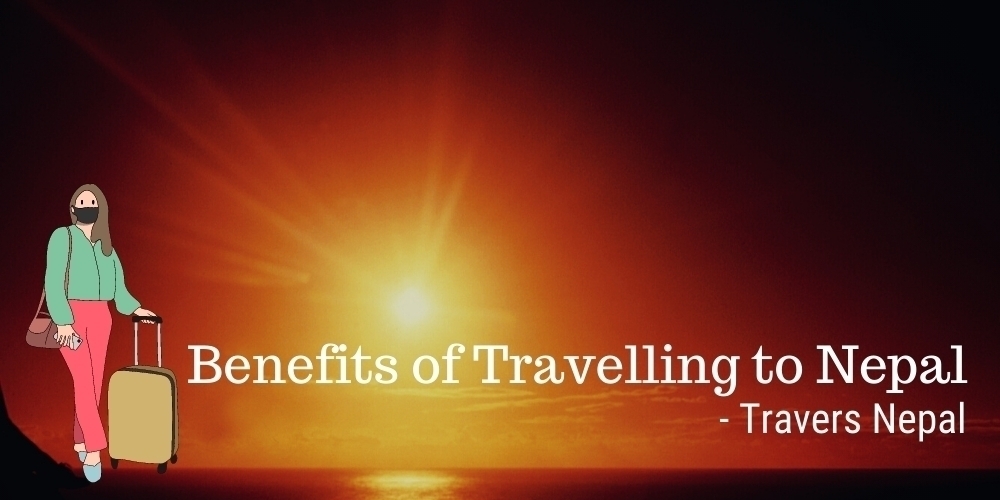
Benefits of Travelling to Nepal
Traveling to Nepal can be a truly rewarding and unforgettable experience, offering a range of benefits. Here are some of the main benefits of travelin...
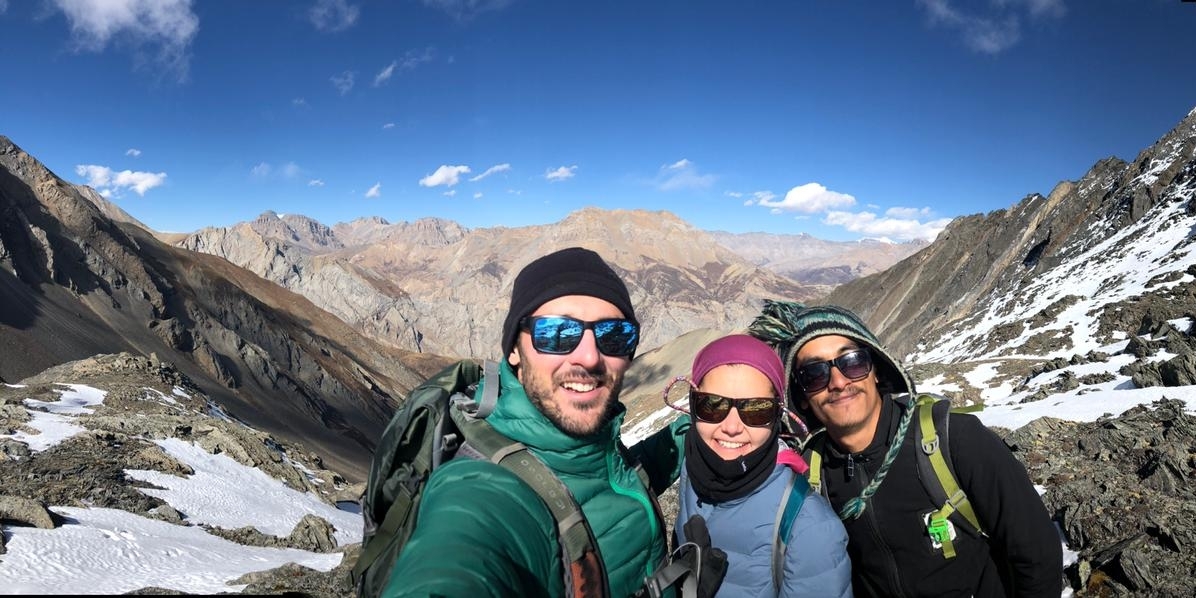
Nepal Travel Guide: Places to Visit Without Guide, TIMS Card, and Permits
Nepal, a country known for its natural beauty and rich culture, has a lot to offer travelers. From the stunning Himalayas to the diverse wildlife, Nep...
Nepal Travel Information: Unveiling the Wonders of the Himalayas
Welcome to a journey through the majestic landscapes, rich cultural heritage, and unparalleled natural beauty of Nepal. As seasoned travelers, we unde...
Join our Newsletter
Nepal Tourist Visa
- Table of contents
Traveling to Nepal
Who needs a nepal visa, nepal tourist visa validity, a complete arrival card, a complete visa application form, a valid passport, receipt of visa fees payment, visa prior to arrival, nepal tourist visa fees, where to apply, nepal tourist visa processing time, visa on arrival, nepal visa extension, nepal tourist visa faqs.
Each year, many tourists come to Nepal to go trekking or mountain climbing, visit historical sites, sample the local cuisine, and engage in other leisure activities. Nepal is home to ten of the fourteen tallest mountains in the world, as well as rich history and vibrant local culture, making it a unique destination for tourists of all kinds.
The following nationalities must apply for a tourist visa prior to traveling to Nepal:
Afghanistan, Cameroon, Eswatini, Ethiopia, Ghana, Iraq, Liberia, Nigeria, Somalia, Syria, Zimbabwe, and Palestine.
The Nepal Tourist visa is intended as a travel document for leisure purposes including, but not limited to, sightseeing, touring, trekking, and visiting friends/family.
Tourist visas are available for different periods of stay. Applicants can request a 15-day, 30-day, or 90-day visa when they apply. Tourists may not stay more than 150 days within a visa year (January to December) including extensions. The Tourist visa is available as a single-entry and multiple-entry visa.
Nepal Tourist Visa Requirements
To apply for a Nepal Tourist visa, all applicants will have to submit some basic documents depending on their nationality and the method of submission.
The following list contains the requirements for both the Tourist visa on arrival and the Tourist visa prior to arrival:
The Arrival Card must be filled out upon arrival in Nepal at the Tribhuvan International Airport.
Applicants can complete the Tourist visa application form through the official online portal before arriving or at one of the kiosks upon arrival. Applicants will receive a confirmation receipt with an official barcode. They must have the receipt with them when they approach the immigration officer for visa processing.
Passports (or travel documents) must be valid upon arrival in Nepal. Passport copies and handwritten passports are not accepted.
Payment can be made at the visa collections counter upon arrival to the airport. Applicants must present the receipt of payment to the immigration officer for visa processing.
The application form can be completed online . Applicants will receive a receipt of submission with an official barcode.
Passports (or travel documents) must be valid for at least six months from the date of entry into Nepal and have at least two blank pages for official use. Passport copies and handwritten passports will not be accepted.
The payment method will depend on the embassy or consulate where the applicant submits their tourist visa application.
Nepal Tourist Visa Application
Depending on whether the Tourist visa is a visa on arrival or a visa obtained prior to arrival, the visa application steps may include:
All travelers arriving in Nepal must complete an Arrival Card.
Application forms can be completed through the official online portal or at the Tribhuvan International Airport upon arrival. Either way, travelers must have a confirmation receipt with a valid barcode on it to present to the immigration officers at the Nepalese border.
There are several methods of payment available at the visa fees collection counter at the Tribhuvan International Airport. Applicants must keep the receipt of their payment to present to the immigration officer at the border.
Applicants can present their application form submission receipt, passport (or travel documents), and the receipt of payment for the visa fees to the immigration officer at the border for processing.
Application forms can be filled out through the official online portal . Applicants must print the completed form and their confirmation receipt with the valid barcode.
Applicants must prepare all the documents required by the relevant Nepalese embassy or consulate where they plan to submit their visa application.
Depending on the location of submission, the applicant must either retrieve their passport with the new tourist visa stuck inside from the embassy or consulate OR they will receive the passport by post.
The fees for the Nepal tourist visa will depend on the intended duration of stay and the number of entries. For a stay of 15 days, the cost is 30 USD; for a stay of 30 days, the cost is 50 USD; and for a stay of 90 days, the cost is 125 USD.
Some categories of applicants are exempt from the visa fees, including:
- Children under 10 (except US citizens)
- SAARC Citizens (except Afghanis) once a visa year (January to December) for stays of up to 30 days.
- Non-Residential Nepalese (NRN) cardholders
- Chinese Nationals
The Nepal Tourist visa can be obtained by most foreign nationals as a visa on arrival.
Nationals from Afghanistan, Cameroon, Eswatini, Ethiopia, Ghana, Iraq, Liberia, Nigeria, Somalia, Syria, Zimbabwe, and Palestine must apply for the Tourist visa via the relevant Nepalese Diplomatic Mission (embassy or consulate).
The processing time for the Nepal Tourist visa will vary depending on the applicant’s nationality and the method of submission.
Approved Visa Applications
After presenting the required documents to the immigration officer, travelers will receive a decision on the spot. If the Tourist visa is approved at the airport, the applicant will be permitted to enter the country immediately.
If approved, the applicant can retrieve their passport with the tourist visa stuck inside from the relevant embassy. Alternatively, they might receive the passport with the visa by post. It’s important to double-check that the visa information matches the identification information as written on the passport.
It is possible to extend the Nepal Tourist visa for up to 150 days in a single visa year (January to December). Extensions must be made for a minimum of 15 days. The cost is 3 USD per day. There is a 5 USD per day late fine if any delay occurs. An additional 25 USD will apply for tourists who request multiple entries.
The Tourist visa is a travel document that allows foreign nationals to enter Nepal for leisure purposes such as sightseeing or visiting friends/family.
The Nepal Tourist visa is available for periods of stay of 15 days, 30 days, and 90 days. It can be extended for up to 150 days in a single visa year (January to December). The period of stay will be determined based on the purpose of travel.
The fees for the Nepal tourist visa will depend on the intended duration of stay and the number of entries. For a stay of 15 days, the cost is 30 USD; for a stay of 30 days, the cost is 50 USD; and for a stay of 90 days, the cost is 125 USD. Some categories of applicants are exempt from the visa fees, including: • Children under 10 • SAARC Citizens (except Afghanis) once a visa year (January to December) for stays of up to 30 days. • Non-Residential Nepalese (NRN) cardholders • Chinese Nationals
The Nepal Tourist visa can be obtained by most foreign nationals either online through the official immigration portal or as a visa on arrival at the Tribhuvan International Airport. Nationals from Afghanistan, Cameroon, Eswatini, Ethiopia, Ghana, Iraq, Liberia, Nigeria, Somalia, Syria, Zimbabwe, and Palestine must apply for the Tourist visa via the relevant Nepalese Diplomatic Mission (embassy or consulate).
Check if you need a visa for your next destination
Latest news and articles.

Greece unveils visa-on-arrival program for Turkish tourists to 10 islands

Ireland imposes visa requirements on citizens of Dominica, Vanuatu, and Honduras

The essential traveler's guide to understanding various types of visas
Electronic Travel Authorization for Visa
All passengers travelling to Nepal by air or land route no longer require a proof of COVID Vaccinations (COVID pass) or a negative PCR test report of COVID-19.
Notice Regarding the Introduction of Electronic Travel Authorization (ETA) Visa System
Electronic Travel Authorization (ETA) for Tourist Visa
- Online Electronic Travel Authorization application form for Tourist Visa ( https://nepaliport.immigration.gov.np/onlinevisa-mission/application ).
- ETA application submission time:- 9:15-13:00 hrs OR 14:00-15:30 hrs (on weekdays except public holiday including bank holiday).The appointment is not required.
- The traveller should submit valid physical passport (with validity of a minimum period of six months) either in person or via post to the Embassy along with the print-out of the visa application.
- After the Embassy verifies the ETA application, the traveller is required to pay for ETA.
- Children under the age of 10 shall be issued gratis ETA free of cost.
- ETA document can be collected on the same day if applied in person. If the application is made by post, the processing time is 3 working days.
- Card Payment (Visa Debit/Credit, Master Card Debit/Credit, All Maestro cards) is accepted for the payment of visa fees. A virtual payment link will be sent to the applicant’s email if visa application is made by post.
- A self-addressed return envelope should also be sent to the Embassy if applied by post.
- Please note Non-UK Passport holders should submit a UK residence permit in addition to other required documents
Electronic Travel Authorization for Travel Document Holders and the Nationals of
Nigeria, Ghana, Zimbabwe, Cameroon, Swaziland, Somalia, Liberia, Iraq, Ethiopia, Palestine, Syria and Afghanistan
Documents Required For Travel Document Holders issued by the Government of UK, those who have been in the United Kingdom in a refugee status:
- Original travel document with at least 6 months’ validity
- A copy of citizenship certificate of the sponsor and signed sponsorship letter
- A copy of UK resident permit card
- Proof of Address
- Details of Confirmed Hotel reservation
- Valid Confirmed Air Ticket
- Latest 1 month Bank Statement
- Processing Time: One week
- Online Electronic Travel Authorization application form ( https://nepaliport.immigration.gov.np/onlinevisa-mission/application ).
Applicants can submit their documents for ETA and collect their passports in person or through their agents/representatives or by post as well.
For the application received by post, a Virtual Payment (Visa Debit/Credit, Master Card Debit/Credit, All Maestro cards) link will be sent to the applicant’s email once the application is received at the Embassy.
Please do not enclose a postal order or a bank draft for the payment of visa fees now onwards.
The applicants from the United Kingdom can enclose a Self Addressed Envelope with Special Delivery Stamp as per necessity with the application. (*Please do not use printed stamp and label)
Diplomatic and Official
Electronic travel authorization, eta for diplomatic visa.
ETA for diplomatic visa shall be issued to a person holding a diplomatic passport who needs to visit Nepal in connection with his/her official duty.
- Original Diplomatic/Official passport with at least 6 months’ validity with at least two empty pages.
- One recent passport-size photograph
- A note verbale from the Foreign Ministry/diplomatic mission/ international organisation or equivalent offices with a request for an ETA for diplomatic visa, stating clearly the purpose and period of the visit.
- Online Electronic Travel Authorization application form for Official/Diplomatic Visa ( https://nepaliport.immigration.gov.np/onlinevisa-mission/application )
ETA fees will be as follows:
** Once visa issued, it will be valid up-to six months only, so please enter the country within six months of visa issued date & DO NOT apply for a visa after or before 6 months you travel.
**Please note: Once the ETA is approved/issued, the fees will not be refunded.
** Tourist visas can be obtained on arrival at entry points except for the nationals of Nigeria, Ghana, Zimbabwe, Cameroon, Swaziland, Somalia, Liberia, Iraq, Ethiopia, Palestine, Syria and Afghanistan.
**Refugees travelling with travel documents will require ETA before arrival.
Visitors may also obtain tourist visa at following arrival points in Nepa l: Click here for Arrival points
Visa Extension:
A tourist visa can be extended from the Department of Immigration and Pokhara Immigration Office for a total of 120 days.
An additional 30 days visa may be granted on reasonable grounds from the Department.
Over the course of a visa year, a tourist cannot stay in Nepal more than cumulative 150 days.
Non-Residential Nepalese Visa:
1.If any foreigner of Nepalese origin residing in foreign country wish to reside or conduct business, profession or Study, teach in any subject in Nepal, ETA for non-residential Nepalese visa may be issued to him and of his family.
2. The format of non-residential Nepalese visa shall be under Appendix 3b.
For Rules and Appendix Please see link below Immigration office, Nepal
For more information please contact us on 02072291594 or email: [email protected]
Update April 12, 2024
Information for u.s. citizens in the middle east.
- Travel Advisories |
- Contact Us |
- MyTravelGov |
Find U.S. Embassies & Consulates
Travel.state.gov, congressional liaison, special issuance agency, u.s. passports, international travel, intercountry adoption, international parental child abduction, records and authentications, popular links, travel advisories, mytravelgov, stay connected, legal resources, legal information, info for u.s. law enforcement, replace or certify documents.
Before You Go
Learn About Your Destination
While Abroad
Emergencies
Share this page:
Travel Advisory December 18, 2023
Nepal - level 2: exercise increased caution.
Reissued after periodic review with updates to risk indicators and "if you decide to travel" section.
Exercise increased caution in Nepal due to the potential for isolated political violence .
Country Summary: Political demonstrations intended to be peaceful can sometimes escalate into violence and may be met with force by Nepali authorities.
Read the country information page for additional information on travel to Nepal.
If you decide to travel to Nepal:
- Avoid demonstrations and crowds.
- Do not trek or climb alone. The Government of Nepal requires solo or foreign independent trekkers (FITs) to use a local guide or porter while trekking in Nepal's official national parks and protected areas.
- Review the Adventure Travel Page before your trip.
- Enroll in the Smart Traveler Enrollment Program ( STEP ) to receive Alerts and make it easier to locate you in an emergency.
- Follow the Department of State on Facebook and Twitter .
- Review the Country Security Report for Nepal.
- Visit the CDC page for the latest Travel Health Information related to your travel.
- U.S. citizens who travel abroad should always have a contingency plan for emergency situations. Review the Traveler’s Checklist .
Embassy Messages
View Alerts and Messages Archive
Quick Facts
Must have six months remaining validity or more at time of entry.
At least one blank visa page (not endorsements page) required for entry visa.
COVID-19 vaccination/negative PCR test report is not required (Effective May 26, 2023)
US $5,000; Pure/raw/unworked gold and silver are strictly prohibited; Worked gold/jewelry up to 50 grams and worked silver/jewelry up to 100 grams are allowed. Indian currency in denominations greater than 100 rupees notes.
US $5,000; Pure/raw/unworked gold and silver are strictly prohibited; Worked gold/jewelry up to 50 grams and worked silver/jewelry up to 100 grams are allowed; Indian currency in denominations greater than 100 rupees notes. Nepalese currency no more than Rs. 5000.
Embassies and Consulates
U.s. embassy kathmandu.
Maharajgunj Kathmandu, Nepal Telephone: +(977)(1) 423-4000 or 423-4500 Emergency After-Hours Telephone: +(977)(1) 400-7266 Email: [email protected]
Destination Description
Learn about the U.S. relationship to countries around the world.
Entry, Exit and Visa Requirements
STRONGLY RECOMMEND: No Solo Trekking; Follow Medical Advice regarding High Altitude Mountain Sickness; Review customs policies prior to travel
The Department of Immigration rescinded all previously issued orders regarding country-specific travel limitations. All travelers regardless of vaccine status can receive on-arrival visas at the port of entry. Amendments to existing orders and new orders may be promulgated with little notice. Please continue to monitor this space and local media for additional information.
Effective May 26, 2023, travelers entering Nepal from abroad by air or land are no longer needed to submit certificate of full vaccination against COVID-19. A negative PCR test report for COVID-19 is not required.
Quarantine is currently not required for travelers regardless of their vaccine status, nationality, or recently visited locations.
Travelers departing Nepal by air are subject to health protocols of their destination country only. The airlines are responsible for ensuring passengers meet requirements of destination countries. Please consult with your airlines prior to your arrival and departure from Nepal. Please check with your airline regarding future flight availability and any necessary flight re-bookings. Operation of cargo flights, rescue flights, and evacuation flights will be carried out subject to special permission.
Requirements for Entry:
- Passport must have six months or more validity remaining at the time of entry
- One blank visa page available in passport for visa (not endorsements page)
- Nepali authorities generally allow entrance on an emergency passport printed overseas
- Visa appropriate for purpose of travel
Customs: International travelers arriving and departing Nepal via international airport(s) are permitted to no more than one of the following personal items:
- Electronic tablet/laptop, video camera, and camera
- Portable music system
- Perambulator or tricycle
- Cellular mobile phone
- Pure/raw/unworked gold and silver are strictly prohibited to carry through ports of entry. Worked gold / jewelry up to 50 grams and worked silver/ jewelry up to 100 grams
- Items for professional use, including drones (check in advance with the Nepal Department of Customs)
Regular Tourist Visas:
- If you will arrive by air, either apply for a tourist visa at a Nepalese embassy or consulate before traveling or purchase a tourist visa upon arrival at Tribhuvan International Airport in Kathmandu. NB: Pre-arrival visas are subject to availability. Check with the nearest Nepalese embassy or consulate for current availability.
- For an online visa application form , see https://online.nepalimmigration.gov.np/tourist-visa . Note that obtaining a visa on arrival may take several hours.
- If you will arrive by land , you are responsible both for obtaining a visa and going through the necessary immigration formalities. U.S. citizens may not be stopped by border officials in either direction to process immigration and visa documentation. Consequences for non-compliance are severe and have included lengthy prison sentences and large fines.
- When crossing by land into Nepal, U.S. citizens should carry U.S dollar bills to pay their Nepali visa fee. U.S. citizens travelling by land from India to Nepal should be aware that Nepali visa fees must be paid in cash in U.S. dollars. Credit cards or other currencies will not be accepted. All U.S. bills must be new (no older than 2003) and in good condition (no tears, excessive wear, creases, visible repairs, etc.) Individuals crossing the border by foot are provided 24 hours service.
- If you do not have a visa and do not receive an entry stamp from an immigration officer, you will not be allowed to depart Nepal and may face additional consequences.
- U.S. citizens can purchase an on-arrival tourist visa at the following land border points of entry:
- Pashupati Nagar, Jhapa District (Eastern Nepal, currently closed)
- Kakarvitta, Jhapa District (Eastern Nepal, currently closed)
- Biratnagar, Morang District (Southeastern Nepal, only arrival; No Departure)
- Birgunj, Parsa District (Central Nepal, arrival and departure)
- Belahiya, Bhairahawa, Rupandehi District (Southern Nepal, arrival and departure)
- Jamunaha, Nepalgunj, Banke District (Mid-West Nepal, currently closed)
- Mohana, Dhangadi, Kailali District (Southwest Nepal, currently closed)
- Gadda Chauki, Mahendranagar Kanchanpur District (Western Nepal, only arrival; No Departure )
- Hilsa, Humla District (Far Western Nepal, for group tourists only; arrival and departure)
- Korala, Mustang District (North-west Border, currently closed)
- Timure, Rasuwa District (Northern Border; arrival and departure)
- Kodari, Sindhupalchowk District (NortheastBorder– for group tourists only; arrival and departure)
Tourists obtaining visas provided on-arrival by the Nepali Department of Immigration may stay no more than 150 days in any given calendar year. Visas will only be given in 15, 30, or 90 day increments, but may be extended at the Department of Immigration office in Kathmandu.
Tourists may request the following visa at the time of arrival at TIA and checkpoints:
- 15 days multiple-entry tourist visa (approx. $30 USD)
- 30 days multiple-entry tourist visa (approx. $50 USD)
- 90 days multiple-entry tourist visa (approx. $125 USD)
Visa fees are payable in U.S. dollars. While money-changing and ATM services are available at the airport, credit card payment is not a reliable option, and ATM machines occasionally malfunction.
Other Visa Categories:
As of January 2023, all foreign travelers must arrive in Nepal on a tourist visa and can only convert their visa to a different category after arrival. Check with the Department of Immigration for visa details and the online application for various types of visas, including student and work visas. Your purpose of travel will dictate what category of visa you will need to obtain. If you intend to apply for a study or work visa from Nepal, it is strongly advised to start the visa conversion process with the institution/employer and the concerned government authorities at least two months prior to expiration of your tourist visa. Non-tourist visa issuance has been known to take months to process and stays beyond 150 days on a tourist visa will lead to deportation with overstay fines and penalties.
Extending Your Visa:
- The Department of Immigration headquarters in the Kalikasthan neighborhood of Kathmandu is the only office that can extend all category visas.
- The Immigration Offices in Pokhara, Kakarvitta, Birgunj and Belahiya can extend tourist, relationship (marriage) and Non-Residential Nepali (NRN) visas.
- Visitors should apply to extend their visas before the expiration date; failure to do so will result in penalty and late fees.
- Long overstays beyond the expiration date can result in heavy fines, arrest, and detention pending formal deportation proceedings, followed by a ban on re-entry.
- Payment at the Department of Immigration can be made only in cash via Nepali rupees or U.S. dollars.
Requirements for Exit:
- You must have a valid visa in a valid passport before you will be allowed to depart Nepal. If your visa has expired, you must extend your visa before you will be allowed to depart.
- The Immigration Office at Tribhuvan International Airport is not authorized to extend visas. Travelers who have tried to extend their visa at the airport will be sent to the Immigration Office in Kathmandu to pay the extension fee and, as a result, many travelers have missed their flights.
- If you renew or replace your passport at the Embassy in Kathmandu, you must go to the Department of Immigration to transfer your Nepali visa by pasting a new visa into the new passport. Transferring a visa from one passport into another on one’s own is a serious crime in Nepal, with punishments of up to 9 years in prison and significant fines.
- See the Government of Nepal’s Department of Immigration website for additional immigration information.
Travel across the Nepal-China Border:
You may encounter immigration difficulties with Chinese authorities when traveling across the Nepal-China border on land in either direction. Chinese authorities often require U.S. citizens and other foreign tourists to organize "group" tours through established travel agencies as a prerequisite for obtaining visas and entry permits into Tibet. Chinese authorities have occasionally closed the border, especially around the anniversary of significant events in Tibet. For current information on border crossing status, check with the Embassy of the People’s Republic of China in Nepal . Please read the Department of State’s travel information for China and check for current regulations on entry into Tibet.
HIV Restrictions:
The Department of State is unaware of any HIV/AIDS entry restrictions for visitors or foreign residents of Nepal.
Surrogate Births:
Surrogacy was halted by the Nepal Supreme Court on August 25, 2015 and the practice was formally banned by a Cabinet decision on September 18, 2015, using the Supreme Court decision date as a cut-off. The Supreme Court’s final verdict was announced on December 12, 2016, and holds that surrogacy is legal for infertile Nepali married couples, but illegal for single men or women, transgender couples, and foreign nationals. Surrogacy services are not permitted in Nepal. This includes ancillary services such as birth documentation and the issuance of a visa/exit permission in cases where the child was born in Nepal, even where IVF/surrogacy services were provided outside of Nepal. Without a visa/exit permission a newborn child will not be able to leave Nepal.
U.S. Military Personnel and DOD Contractors:
DOD personnel must review the Foreign Clearance Guide (FCG) for travel to Nepal. All official travel and active duty personal travel must be submitted through an APACS request . Contact information for the Defense Attaché Office can be found in the FCG if you have additional questions.
Dual Citizenship
Nepali law does not permit dual citizenship. Any citizen of Nepal who by naturalization or registration acquires the citizenship of another country shall cease to be a citizen of Nepal.
Find information here on dual nationality , prevention of international child abduction , and customs .
Safety and Security
All U.S. Citizen travelers are encouraged to enroll into Smart Traveler Enrollment Program while traveling abroad. This is a free service that allows U.S. citizens traveling or living abroad to receive the latest security updates from the U.S. Embassy. Enrolling in STEP will help the U.S. embassy contact them and provide assistance during an emergency overseas.
U.S. government employees on official travel to Nepal must seek approval before traveling outside of Kathmandu Valley.
Political-Related Violence: The potential for isolated political-related violence remains a real risk in Nepal. There are occasionally small-scale improvised explosive device (IED) incidents in various parts of Nepal, particularly during periods of heightened political tension. Reported incidents have not been directed toward Westerners or Western interests but have caused injury and damage to nearby individuals and property. The Embassy is also aware of extortion attempts and threats of violence by a local group against private businesses and aid organizations, including local and international schools within the Kathmandu Valley. Historically, violent political activity has been more prevalent in the Terai – the southern plains region of Nepal bordering India – than elsewhere in Nepal. Demonstrations have on occasion turned violent, although these activities generally have not been directed at U.S. citizens.
Bandhs: Bandhs (general strikes) were formerly a common form of political agitation in Nepal but have occurred only infrequently in recent years. Bandhs are unpredictable, may include violent incidents, and can occur with little notice. They can cause schools and businesses to close and can stop traffic. Individuals not complying with bandhs may be harassed, and in extreme cases assaulted, by supporters. If you plan air travel to or from Nepal during a scheduled bandh, please note that transportation may be affected. Usually, bandh organizers allow specially marked buses operated by the Nepal Tourism Board to travel between the airport and major tourist hotels. Do not attend or approach political demonstrations or checkpoints established during bandhs.
Avoid all unnecessary travel where bandhs are occurring.
Actions to Take:
- Avoid all large gatherings, protests, and demonstrations.
- Report any difficulties or security concerns to police.
- Monitor local media for updates.
- Do not engage in argumentative or combative behavior if challenged or told that you cannot go to access a certain area.
- Keep a low profile.
- Be aware of your surroundings.
Crime: Although relatively low, crime in Kathmandu and throughout the country has risen in some categories, including:
Financial Crimes and Theft:
- Pickpocketing and bag-snatching may occur at major tourist sites, including the Thamel area of Kathmandu. Store valuables, including passports and cash, in the hotel safety deposit box; do not carry them. The Nepal Tourist Police recommend that you carry a photocopy of your passport when going out.
- Exchange money only at banks, hotels and government authorized money exchanger. Criminals use sophisticated scams, such as ATM skimming, particularly in Kathmandu.
- Avoid walking alone after dark, carrying large sums of cash, and wearing expensive jewelry.
- See the Department of State and the FBI pages for information on scams.
Violent Crimes:
- Travel in groups, especially at night.
- While not common, sexual assaults against foreigners have been reported, including in popular tourist areas of Kathmandu and Pokhara, and in remote mountainous areas.
- Be aware of your surroundings. Foreigners have occasionally had sedative drugs added to their food or drink by individuals who seek to rob or otherwise take advantage of them. Solo travelers should take extra precautions to ensure their personal safety. We strongly recommend no solo trekking. Local guide service is available in trekking regions.
- Nepali police forces may have limited resources to deter and investigate crimes. Many criminal cases reported to the police remain unresolved.
- U.S. citizen victims of domestic violence may contact the Embassy for information on available resources and assistance.
Victims of Crime: Report crimes to the local police by dialing “100" as soon as incident occurs. This number is equivalent to “911” in the United States, and it is staffed 24/7 by the local police. When calling the emergency number, speak slowly and clearly so that your message gets across to the official without misunderstanding. Tourist Police , who can be reached by dialing “1144, +977-01-4247041 or +977-9851289444” have good English language capabilities and also stand ready to assist in popular tourism areas. Remember that local authorities are responsible for investigating and prosecuting crimes. For additional information, visit the State Department’s webpage on help for U.S. victims of crime overseas .
U.S. citizen victims of crime in Nepal may always contact the U.S. Embassy in Kathmandu for assistance. Sexual assault victims might be more comfortable contacting the Embassy before reporting the crime to local authorities. In the event of a crime, the Embassy can:
- Help you find appropriate medical care
- Assist you in reporting a crime to the police
- Contact relatives or friends with your written consent
- Provide a list of local attorneys
- Provide information on victim’s compensation programs in the United States
- Provide an emergency loan for repatriation to the United States and/or limited medical support in cases of destitution
- Help you find accommodation and arrange flights home
- Replace a stolen or lost passport
Tourism: No formal tourism industry infrastructure is in place. Tourists are considered to be participating in activities at their own risk. Emergency response and subsequent appropriate medical treatment is not available in-country. U.S. citizens are encouraged to purchase medical evacuation insurance and be aware of potential insurance fraud. See our webpage for more information on insurance providers for overseas coverage .
Local authorities are generally the best first responder in emergency situations. Many local resources are available by phone, although it may become necessary to flag down an officer or visit a local police or government office.
In the event of an emergency, dial 100 to contact the police in Nepal. This number is equivalent to “911” in the United States, and it is staffed 24/7 by the local police. Their toll free number is 16600141916 .
Tourist Police have good English language skills and are often a better point of contact for foreigners than the regular police. They generally stand ready to assist in popular tourism areas. Dial 1144 for the tourist police hotline. They can be reached at +977-01-4247041 or +977-9851289444. The Tourist Police Office is located at Bhrikuti Mandap, Kathmandu, Tourist Service Center Building.
Nepal Police telephone directory is available for quick reference.
Dial 101 for fire. Dial 102 for ambulance service. Dial 103 for traffic control. Dial 197 for telephone inquiry.
U.S. citizens requiring emergency assistance may contact the U.S. Embassy at any time. For an emergency involving death, arrest, serious illness or injury, or anything that threatens the life or safety of a U.S. citizen in Nepal during the weekends and holidays, call +977-01-423-7266. During normal business hours, call the operator at 01-423-4000 and tell that you have a U.S. citizen emergency and ask to be transferred to the American Citizen Services Unit. After normal business hours, describe your U.S. citizen emergency to the operator and ask to be connected with the Duty Officer, who is on-call at all times for emergency situations involving the life and safety of U.S. citizens, but cannot assist in any way with visa inquiries or routine services. If the primary number does not work, you can also call the analog back-up number, +977-01-423-4500.
The State Department’s Office of Overseas Citizens Services also stands ready to assist. From the United States and Canada, dial +1-888-407-4747 and from overseas dial +1-202-501-4444. General information on the range of emergency services that the office of Overseas Citizen Service makes available to U.S. citizens overseas is available at http://travel.state.gov .
(The “+” sign indicates your international dialing prefix, which is 011 in the United States and 00 in most other countries. For example, if dialed from the United States, the normal business hours number is 011-977-1-423-4000.)
Local Laws & Special Circumstances
Arrests and Consequences: You are subject to local laws. If you break local laws in Nepal, your U.S. passport will not help you avoid arrest or prosecution. If you violate local laws, even unknowingly, you may be expelled, arrested, or imprisoned. If you are arrested in Nepal, the authorities may keep you in detention for weeks or even longer during the investigation stage. Punishment for violations of criminal laws in Nepal range from fines to imprisonment, depending on the crime. Furthermore, some laws are also prosecutable in the United States, regardless of local law. For examples, see crimes against minors abroad and the Department of Justice website.
Arrest Notification: If you are arrested or detained, ask police or prison officials to notify the U.S. Embassy immediately. See our webpage for further information.
Driving Under the Influence: Driving in Nepal after consuming any amount of alcohol could result in arrest.
Illicit Drugs: A variety of illegal drugs are available in Nepal. Purchasing, possessing or consuming illegal drugs, including marijuana and hashish, could result in both fines and jail time.
Firearms and Ammunition: You may not bring any kind of firearm or ammunition into Nepal. Violators who bring in firearms or ammunition – even imitations or in jewelry form – may be prosecuted.
SPECIAL CIRCUMSTANCES
TREKKING IN NEPAL
Solo Trekking: DO NOT TREK ALONE. The U.S. Embassy in Kathmandu strongly discourages U.S. citizens from hiking alone or even separating from larger traveling parties while on a trail. In recent years, U.S. citizens and other foreigners have disappeared, been seriously injured, or been victims of violent crime while trekking alone. In some cases, even after extensive search efforts, missing solo trekkers have not been found. The safest option for trekkers is to join an organized group and/or use a reputable trekking company that provides an experienced guide and porters who communicate in both Nepali and English. Effective April 1, 2023, new requirements established by the Nepal Tourism Board (NTB) and more than a dozen trekking organizations, with the support of Nepal’s Ministry of Culture, Tourism, and Civil Aviation, will require solo or foreign independent trekkers (FITs) to use a local guide from licensed trekking guide and obtain Trekking.
Information Management System (TIMS) card through authorized trekking agencies registered with the Government of Nepal while trekking in Nepal’s official national parks and protected areas. Failure to comply with this requirement may result in considerable fines. Please review travel related information on the official websites of the Nepal Tourism Board and the U.S. Embassy-Kathmandu prior to travel.
Natural Disaster Risks: Trekking in Nepal comes with the risk of natural disaster. DO NOT TREK ALONE. Trekkers should be alert to the possibility of avalanches, landslides, and falling rocks, even when trails are clear. Although these risks existed prior to the April 2015 earthquake and its aftershocks, earthquakes have further destabilized some mountainous areas, causing severe landslides in some affected areas. Monsoon rains, which generally begin in June and largely end in September, may destabilize steep slopes and mountainsides. During the monsoon season, floods and landslides regularly damage travel infrastructure and telephone services, complicating efforts to locate U.S. citizens and arrange medical evacuations. Consult carefully with trekking agencies for current, location-specific information, and heed warnings of potential danger. Provide family or friends with a detailed itinerary prior to trekking and check in at all police checkpoints where trekking permits are logged. Register your itinerary through the STEP enrollment process. Before leaving Kathmandu, trekkers can check with the Himalayan Rescue Association (phone: +977-1-444-0292/444-0293) for reliable information about trail conditions and potential hazards of traveling in the Himalayas. We strongly recommend supplemental travel and evacuation insurance.
Altitude Risks: Everyone, regardless of age, experience, or fitness level, should exercise caution when trekking at high altitudes. Many popular trekking routes in Nepal cross passes as high as 18,000 feet. Only experienced mountain climbers should tackle the Himalayas. DO NOT TREK ALONE. Acclimatization is best achieved by walking slowly, rather than hurrying, to cover the distance at high altitudes. Without acclimatization, trekkers of all ages, experience, and fitness levels can experience acute mountain sickness (AMS), which can be deadly. Speak with your doctor or medical professionals in Kathmandu for specific recommendations. We strongly recommend supplemental travel and evacuation insurance.
Evacuation by Helicopter: Obtain emergency medical evacuation insurance before visiting Nepal. Many foreigners require or request evacuation by helicopter from Nepal’s rugged mountain terrain. Most hospitality employees along trekking routes can connect you with a helicopter evacuation service provider. Helicopter companies will generally require either specific evacuation insurance, pre-approval from your health insurance, or payment upfront by credit card in order to assist. Carry appropriate insurance and travel with credit card information. If you hope to have health insurance pay large bills without pre-approval, please note that the service provider may ask to hold onto your passport pending receipt of payment.
Lodging and Travel: During peak trekking seasons, generally spring and autumn, hotel rooms may become scarce. Make advance booking for hotel rooms and plan for possible flight/airport delays. Domestic air flight cancellations and delays occur frequently because of bad weather, including to and from Lukla (gateway to the Everest Base Camp trek) and Jomsom (gateway to the Mustang region). Leave ample time to catch outbound international flights when connecting from domestic flights. Be aware that many hotels in Nepal do not meet international fire or earthquake safety standards.
TIMS Card and Trekking Permits: The Government of Nepal has authorized the Trekking Agency Association of Nepal (TAAN) and the Nepal Tourism Board (NTB) to implement a system for foreign hikers called the Trekkers’ Information Management System (TIMS). Foreign visitors on hiking trips in Nepal, including those not with organized hiking groups, are required to have a valid TIMS card through authorized trekking agencies registered with the Government of Nepal. In case of an emergency, this system helps authorities find trekkers.
Special Permits for Restricted Areas: Trekking in certain remote areas of Nepal and in national parks may require additional permits or fees. Travelers may consult with an experienced tour agency, or review the website of the Nepali Department of Immigration for more information. Please be aware that restricted areas have special requirements for helicopter rescue flights, which may delay assistance even in the event of a medical emergency.
Other Outdoor Activities: Nepal offers many exciting outdoor activities that come with a variety of risks. Several tourists have drowned while swimming in Phewa Lake near Pokhara and other lakes in Nepal because of flash floods triggered by monsoon rains, or after becoming entangled in submerged tree branches or roots. Incidents of boats capsizing on choppy water have also occurred. Wear life jackets. Paragliding and ultralight aircraft tourism have become popular in Pokhara, and many new companies offer such services. Weigh the risks involved with paragliding and ultralight aircraft travel; safety standards may or may not follow international best practices. When engaging in adventure activities, Embassy personnel are strongly encouraged to use professional guide services and to carry a Personnel Tracker Locator device. There are also a number of deep and dangerous ravines not clearly visible to pedestrians in Pokhara city, mainly in the outlying areas. Some local residents and foreigners have fallen into these ravines and sustained serious injuries or died. Medical care is limited and often does not meet Western standards.
Volunteering: Nepal’s Department of Immigration considers volunteering as work, and thus requires volunteers to obtain a work visa. Volunteering on a tourist visa is illegal, and can result in detention by immigration authorities, fines, expulsion from Nepal, and lengthy bans on returning to Nepal.
Some visitors to Nepal wish to volunteer at orphanages or other organizations in an effort to help disadvantaged persons – especially children. Others try to help by donating cash or goods. While we applaud this generous spirit, we are aware of reports that many such opportunities – especially those involving volunteering at orphanages or “children’s homes” – are not in fact charities. Instead, they are for-profit enterprises set up to attract donations from abroad and financial support from volunteers. Many of the children are reportedly not orphans, and volunteering at such an organization may indirectly contribute to child exploitation by creating a demand for children who may be trafficked to such locations. Prospective volunteers in Nepal should read a recent report prepared by a U.S.-based NGO in Nepal regarding ethical volunteering , with a focus on issues relating to “voluntourism.” It can be difficult even for those with significant experience in Nepal to determine which organizations provide authentic and valuable opportunities for well-meaning volunteers, and which manipulate goodwill for profit. With respect to orphanages or children’s homes, the Nepali National Child Rights Council can help confirm an organization’s legitimacy. You can direct inquiries to Ms. Namuna Bhusal, [email protected] , +977-9851139474. The NCRC also handles complaints against children’s homes. U.S. citizens should be aware that the Government of Nepal has limited resources to monitor and regulate non-profit organizations. If you are not certain about an organization, you may want to consider routing contributions through a reputable national or international charity to avoid the possibility that your time and money could unknowingly support the exploitation of children. Learn more about best practices for volunteering abroad .
Currency and Money Issues: The Government of Nepal requires travelers to declare either the import or export of currency that exceeds US$5,000 USD in value by filling out a customs declaration form. The Embassy is not aware of any banks or money exchange offices in Nepal that accept U.S.-issued travelers checks or cash U.S. checks. Accordingly, travelers should consider alternative methods of accessing local currency (e.g., exchanging cash U.S. dollars for Nepali rupees at a bank or money exchange office, or withdrawing rupees from an ATM). Travelers should ensure that they keep a copy of the declaration form after customs officials have put the official endorsement and appropriate stamps on the form to prevent any problems upon departure. Please note that this requirement is subject to change and travelers should contact the Embassy of Nepal in Washington, D.C. to obtain the latest information. Carrying Indian currency in denominations greater than 100 rupees notes is illegal/restricted in Nepal. Consequences for violating this requirement generally include seizure of all cash, gold, or jewelry carried, as well as fines and imprisonment. travelers coming to Nepal from India who hope to change Indian currency into Nepali Rupees are advised to bring 100 Indian Rupee notes or lower denominations only. Please note that Nepali Rupees cannot be exchanged outside of Nepal. See the section below on Customs regarding prohibitions on the importation of gold and silver.
Customs: Do not carry any amount of pure gold, more than 50 grams of gold jewelry, or more than 100 grams of silver into Nepal. You will be detained, the valuables will be seized, and you will need to pay a fine equivalent to the full value of the items seized in order to be released.
Nepal customs regulations are complex. Customs authorities enforce strict regulations concerning importation (even temporarily) and exportation of certain items. Do not carry other valuable metals, articles of archaeological or religious significance, wildlife or related items, drugs, or weapons and ammunition. Do extensive research before importing household pets (including cats and dogs), communications equipment, and other items that might be perceived as sensitive. Drones are strictly regulated throughout Nepal and require special permission from the Home Ministry and other government authorities.
Items purported to be for donation to schools, hospitals, and other social organizations have sometimes been confiscated or cleared only after payment of a significant fine for failure to obtain prior approval from the Ministry of Finance . Those wishing to donate items to a charity or any organization in Nepal must obtain prior approval for waiver of the custom fees from the Ministry of Finance by sending a formal request letter (not via email) to the following address:
Spokesperson: Mr. Ananda Kafle Ministry of Finance Singha Durbar Kathmandu, Nepal Tel: +977-1- 4200537 Email: [email protected] The request should include detailed information about the items to be imported, as well as the organizations receiving the donations. The Secretary will review the request and refer it to the Ministerial level for final decision and approval. Note that all requests are processed on a case-by-case basis. It is highly recommended that intended recipient(s) coordinate with the Ministry to get requests processed. Please see additional information about Customs and Import Restrictions.
Dual Nationality: Nepal does not recognize dual nationality. Accordingly, when a Nepali citizen naturalizes as a U.S. citizen, he/she loses his/her Nepali citizenship. Some travelers who have tried to maintain both U.S. and Nepali passports have faced difficulties entering or exiting Nepal. U.S. citizens of Nepali descent may be eligible for a special visa called a “Non-Resident Nepali” or “NRN” Identity Card. The NRN Identity Card allows a holder to open a local bank account, invest, and own certain types of property, subject to certain restrictions. For more information, contact the Nepali Ministry of Foreign Affairs or the Embassy of Nepal in the United States.
Natural Disasters: Nepal lies on an active fault zone and is considered at high-risk for major earthquakes, as demonstrated by the April and May 2015 earthquakes that caused extensive damage in the Kathmandu Valley and other districts. Lack of adequate emergency response vehicles, equipment, and medical facilities, combined with building codes that are not strictly enforced, may multiply the extent of possible catastrophic damage from a major earthquake, especially in the Kathmandu Valley. Nepal is also prone to flooding and landslides. The Government of Nepal’s ability to respond in the event of a natural disaster may be limited. General information about natural disaster preparedness is available from the U.S. Federal Emergency Management Agency (FEMA) .
In Case of Emergency or Natural Disaster:
- Monitor us on Twitter and Facebook for updates.
- Call us in Washington at 1-888-407-4747 toll-free in the United States and Canada or 1-202-501-4444 from other countries from 8:00 a.m. to 8:00 p.m. Eastern Time, Monday through Friday (except U.S. federal holidays).
- Enroll in the Smart Traveler Enrollment Program ( STEP ) to receive security messages and make it easier to locate you in an emergency.
Faith-Based Travelers: As of August 2018, religious conversion and proselytization are illegal in Nepal.
See the following webpages for details:
- Faith-Based Travel Information
- International Religious Freedom Report – see country reports
- Human Rights Report – see country reports
- Best Practices for Volunteering Abroad
LGBTI Rights: Same-sex sexual activity is not criminalized, and lesbian, gay, bisexual, transgender and intersex (LGBTI) persons in Nepal actively and openly advocate for their rights. Nepal, however, remains a conservative and traditional society. Discrimination exists, and reports of non-violent harassment of LGBTI persons have been received. Accordingly, LGBTI travelers may wish to be discreet and avoid public displays of affection. See our LGBTI Travel Information page and section 6 of our Human Rights report for additional details.
Travelers Who Require Accessibility Assistance: Individuals with disabilities may find accessibility and accommodation difficult throughout Nepal. Nepali law prohibits discrimination against persons who have physical and mental disabilities, including discrimination in employment, education, access to health care, and in the provision of other state services. The law mandates access to buildings, transportation, employment, education, and other state services, but these provisions generally are not enforced. Nepal’s poor infrastructure makes it impracticable in many cases for a mobility-impaired traveler to move around the country, including within the Kathmandu Valley. The government is largely ineffective in implementing or enforcing laws regarding persons with disabilities. Except for a few clinics and hospitals, Nepal mostly lacks accessible and appropriate accommodation for individuals with disabilities.
Students: See the Students Abroad page and FBI travel tips .
Women Travelers: See the travel tips for Women Travelers .
General: Although availability of medical care has improved within the Kathmandu valley, outside the valley, it is limited and generally not up to Western standards. Medical facilities are often overwhelmed because of insufficient resources. Emergency medical services, especially in public hospitals, are of poor quality compared to that available in the United States. Routine medical issues and basic emergency surgeries can be performed by clinics and hospitals in Kathmandu. Serious illnesses, however, often require evacuation to the nearest adequate medical facility in a neighboring country. There is minimal mental health care available in Nepal. U.S. citizens with mental health problems are generally stabilized and transported to the United States or to another regional center for care. The U.S. Embassy in Kathmandu maintains a list of local medical facilities and practitioners .
Intestinal tract diseases, including cholera, are present. Food hygiene and sanitary food handling practices are uncommon in Nepal, and precautions should be taken to prevent water and food-borne illnesses. Prudent travelers should avoid raw, green, leafy vegetables during the monsoon season. Malaria is present in the Terai region.
For emergency services in Nepal, dial 102.
Ambulance services are widely available in major cities, but training and availability of emergency responders may be below U.S. standards and is dependent on the quality of hospital from which the ambulance is dispatched.
COVID-19 Testing: Local medical facilities, including outpatient labs, offer PCR COVID-19 tests on a cash basis, paid by the test recipient. Some facilities may offer in-home testing when arranged in advance. Average PCR test costs are $10-15, with expedited results offered for an additional fee. Most results are available within 48 hours. Expedited results may be available in as little as 6 hours. Results are typically sent via email and/or text message with a link to a .pdf file with scannable barcode. Local pharmacies generally stock rapid COVID-19 antigen tests, which typically cost $5-8.
COVID-19 Vaccines: The COVID-19 vaccine is available for U.S. citizens to receive in Nepal on an as-available basis through Nepal government. Those interested in receiving a COVID-19 vaccine should contact local ward authority. Medical providers in Nepal have been trained in English and most reception staff will be able to communicate in English. Visit the FDA's website to learn more about FDA-approved vaccines in the United States.
Assisted Reproductive Technology and Surrogacy: Assisted Reproductive Technology services are widely available in Nepal and are generally safe. Surrogacy is illegal for foreigners and LGBTQI+ citizens in Nepal, and is subject to complex local regulations. Be aware that individuals who attempt to circumvent local law risk criminal prosecution.
Stray Animals: Stray animals are common on the streets of Kathmandu and at popular tourist sites. Visitors should be aware that stray animals may be infected with rabies. The CDC’s Preventing Dog Bites webpage recommends that if you are bitten by an animal, get to a safe place, immediately wash wounds with soap and water, and seek medical attention.
The U.S. Embassy does not pay medical bills. Be aware that U.S. Medicare does not apply overseas.
Medical Insurance: Obtain emergency medical evacuation insurance before visiting Nepal. Serious medical issues and injuries suffered while hiking in remote areas may require evacuation by helicopter to Kathmandu. Those trekking in remote areas of Nepal should factor the high cost of a potential helicopter rescue into their financial considerations. We strongly recommend supplemental insurance to cover medical evacuation, as medical evacuations can cost tens of thousands of dollars. Payment will be expected in cash before the medevac can take place, if there is no insurance coverage. Neither the U.S. Embassy nor the U.S. government pays private medical bills overseas.
Make sure your health insurance plan provides coverage overseas. Most care providers overseas only accept cash payments. See our webpage for more information on insurance providers for overseas coverage .
BEWARE OF MEDEVAC SCAMS: Medevac scams are common in Nepal, particularly for those traveling in the popular trekking regions of Solukhumbu (Everest region) and Annapurna (Pokhara region). Unscrupulous trekking companies and medical providers may pressure trekkers experiencing mild altitude sickness effects to take medevac helicopter flights back to Kathmandu and be transported by ambulance to a hospital, then charged inflated costs to bill insurance companies, with the excess fees split between involved parties. Trekkers themselves are often knowingly involved in these scams. Such activities are illegal in Nepal, but rarely prosecuted and often difficult to discern in advance. Trekkers should use only TAAN-registered trekking agencies and seek information on costs for medical treatment in advance. Travelers should, however, be aware of the life-threatening risks involved with altitude sickness and err on the side of caution when receiving treatment.
Prescription Medication: To avoid problems at port of entry, always carry prescribed medication in the original packaging, along with your doctor’s prescription If traveling with prescription medication, check with the Embassy of Nepal to ensure that the medication is legal in Nepal. Local authorities irregularly enforce restrictions on certain drugs regularly prescribed by doctors in the United States or other foreign countries. To avoid problems, always carry prescription medication in the original packaging, along with your doctor’s prescription.
Vaccinations: Stay up-to-date on all vaccinations recommended by the U.S. Centers for Disease Control and Prevention.
For further health information :
- World Health Organization
- WHO’s Nepal Profile
- U.S. Centers for Disease Control and Prevention (CDC)
- CDC’s Health Information for Travelers to Nepal
Travel and Transportation
Road Conditions and Safety: In Nepal, vehicles are driven on the left-hand side of the road. In general, roads in Nepal are in poor condition and lack basic safety features, resulting in significant numbers of accidents and fatalities. Traffic is poorly regulated and traffic jams are common on major streets. The volume of vehicles on the roads is increasing faster than improvements in infrastructure. Many drivers are neither properly licensed nor trained, vehicles are poorly maintained, and public vehicles are often overloaded.
Nepali law requires that any driver – including U.S. citizens – have a valid Nepali license in order to legally operate a motor vehicle in Nepal. If you drive without a valid local license, you will expose yourself to greater legal liability. The Nepal Department of Transportation does not convert U.S. driver’s license into a Nepali license. Foreign nationals must either pass the driving test in Nepal or obtain an online International Driving Permit.
Nighttime Travel: Avoid nighttime road travel outside the Kathmandu Valley and minimize nighttime travel within Kathmandu because of insufficient street lighting and hazardous road conditions. Embassy personnel are prohibited from traveling at night outside urban areas in Nepal.
Motorcycle Travel: Deaths from motorcycle accidents have risen dramatically in recent years, including urban areas within Kathmandu. Avoid riding motorcycles in Nepal, particularly on highways; and always wear a helmet.
Buses: Long-distance buses often drive recklessly, and bus accidents involving multiple fatalities are not uncommon. It is dangerous to travel on the roofs of buses as live electrical and other communications wires hang low in many places. Traffic police also impose fines and detain individuals for riding on the roofs of buses.
Taxis: Taxis are a safer and more convenient alternative to buses. Almost all taxi drivers in Nepal insist on negotiating the price of the trip in advance, even if the taxi has a meter installed. Online apps for taxis, such as Pathao, are widely used.
Pedestrian Travel: Sidewalks are nonexistent in many areas, and drivers generally do not yield the right-of-way to pedestrians. Pedestrians account for a considerable portion of traffic fatalities in Nepal.
See our Road Safety page for more information.
Aviation Safety and Oversight: As there is no direct commercial air service to the United States by carriers registered in Nepal, the U.S. Federal Aviation Administration (FAA) has not assessed the government of Nepal’s Civil Aviation Authority for compliance with International Civil Aviation Organization (ICAO) aviation safety standards. Further information may be found on the FAA’s safety assessment page .
Domestic air safety is a concern. In recent years, there have been a number of fatal plane crashes on domestic routes in Nepal, including some crashes in which U.S. citizens have been killed. Nepal’s mountain airports, including Lukla and Jomsom, are notoriously dangerous due to challenging weather and terrain. As a result of Nepal’s poor aviation safety record, since 2013 the European Union (EU) has banned all Nepali airlines from flying into or within EU countries. Although Nepali domestic flights are insured, payments to the families of victims of a plane crash are minimal. Domestic air travelers may want to consider flight insurance that will cover domestic flights in Nepal before leaving home. Check Nepal’s air safety profile with the Aviation Safety Network.
For additional travel information
- Enroll in the Smart Traveler Enrollment Program (STEP) to receive security messages and make it easier to locate you in an emergency.
- Call us in Washington, D.C. at 1-888-407-4747 (toll-free in the United States and Canada) or 1-202-501-4444 (from all other countries) from 8:00 a.m. to 8:00 p.m., Eastern Standard Time, Monday through Friday (except U.S. federal holidays).
- See the State Department’s travel website for the Worldwide Caution and Travel Advisories .
- Follow us on Twitter and Facebook .
- See traveling safely abroad for useful travel tips.
Review information about International Parental Child Abduction in Nepal . For additional IPCA-related information, please see the International Child Abduction Prevention and Return Act ( ICAPRA ) report.
Travel Advisory Levels
Assistance for u.s. citizens, learn about your destination, enroll in step.

Subscribe to get up-to-date safety and security information and help us reach you in an emergency abroad.
Recommended Web Browsers: Microsoft Edge or Google Chrome.
Make two copies of all of your travel documents in case of emergency, and leave one with a trusted friend or relative.
Afghanistan
Antigua and Barbuda
Bonaire, Sint Eustatius, and Saba
Bosnia and Herzegovina
British Virgin Islands
Burkina Faso
Burma (Myanmar)
Cayman Islands
Central African Republic
Cote d Ivoire
Curaçao
Czech Republic
Democratic Republic of the Congo
Dominican Republic
El Salvador
Equatorial Guinea
Eswatini (Swaziland)
Falkland Islands
France (includes Monaco)
French Guiana
French Polynesia
French West Indies
Guadeloupe, Martinique, Saint Martin, and Saint Barthélemy (French West Indies)
Guinea-Bissau
Isle of Man
Israel, The West Bank and Gaza
Liechtenstein
Marshall Islands
Netherlands
New Caledonia
New Zealand
North Korea (Democratic People's Republic of Korea)
Papua New Guinea
Philippines
Republic of North Macedonia
Republic of the Congo
Saint Kitts and Nevis
Saint Lucia
Saint Vincent and the Grenadines
Sao Tome and Principe
Saudi Arabia
Sierra Leone
Sint Maarten
Solomon Islands
South Africa
South Korea
South Sudan
Switzerland
The Bahamas
Timor-Leste
Trinidad and Tobago
Turkmenistan
Turks and Caicos Islands
United Arab Emirates
United Kingdom
Vatican City (Holy See)
External Link
You are about to leave travel.state.gov for an external website that is not maintained by the U.S. Department of State.
Links to external websites are provided as a convenience and should not be construed as an endorsement by the U.S. Department of State of the views or products contained therein. If you wish to remain on travel.state.gov, click the "cancel" message.
You are about to visit:
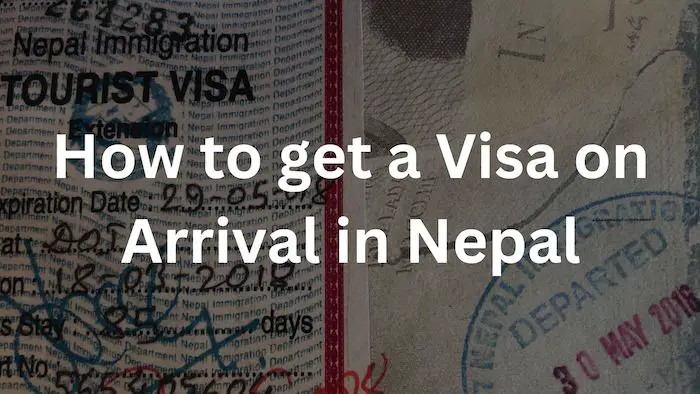
Nepal Visa on Arrival: How to get a Tourist Visa in Nepal
- September 23, 2022
For those planning a trip to Nepal, getting a Nepal Tourist Visa is a requirement. Tourist visas are extended to international travelers for leisure or tourism purposes. For visas in Nepal, you have two options 1) Apply for visa online, before departing for Nepal, and 2) A Nepal visa on arrival.
To help travelers decide if Nepal is an accessible destination to vacation, this blog will cover everything related to visas in Nepal including the application process and requirements to receive a tourist visa.
Who Needs a Visa for Nepal?
To enter Nepal, a visa is mandatory. Notably, citizens of India are exempt from this requirement due to their inclusion in the visa waiver program. Furthermore, individuals from the listed countries must secure a visa before their travel to Nepal, whereas all other nationalities have the option to acquire a Nepal visa upon arrival:
- Afghanistan
How much does a visa on arrival cost in Nepal?
A visa on arrival depends on your length of stay. The cost of the visa in Nepal are:
- 15-day visa – 30 USD
- 30-day visa – 50 USD
- 90-day visa – 125 USD
Can I get a Nepal Visa on Arrival?
Yes, on-arrival visas are available in Nepal. The visa can be purchased at Tribhuvan International Airport in Kathmandu as well as at the India and China border entry points. On arrival, visas can be purchased for 15, 30, or 90 days at 30, 50, and 125 USD respectively.
On-arrival visas in Nepal, are the de-facto tourist visas for tourists traveling in Nepal. The process of getting a visa is relatively simple and quick and can be completed within an hour at the airport, even during peak tourist seasons.

The required documents to get a visa in Nepal are:
- Up-to-date passport
- Completed arrival card
- Online Visa Form (Either prior to arriving in Nepal, or by completing at the airport’s kiosk)
- Cash for visa payment
- Lodging arrangements
To receive a tourist visa in Nepal, you will have to complete the following:
Procedures to receive a Nepal visa on arrival (tourist visa):
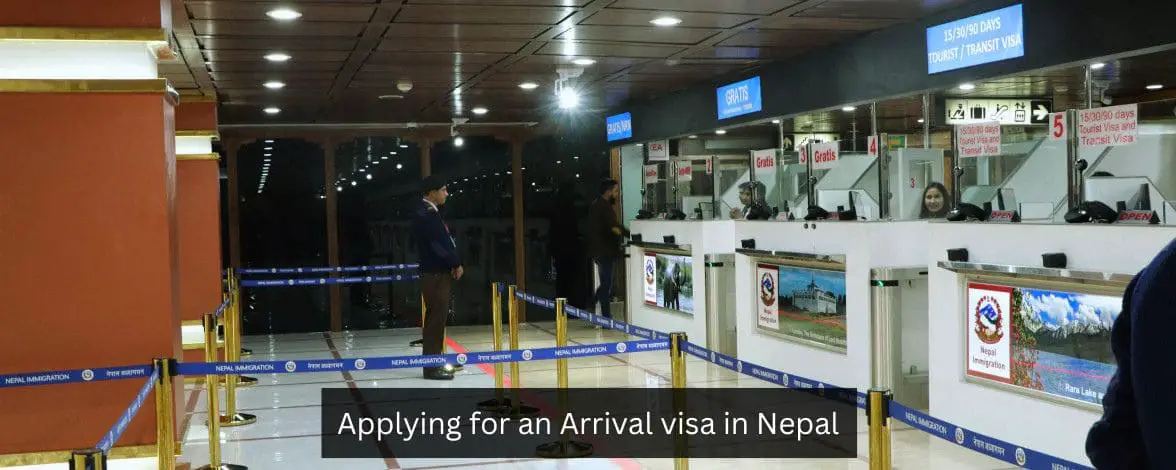
Tourists need to complete three steps once they arrive at Tribhuvan International Airport in Kathmandu or at one of the India and China border entry points. The three steps include the following:
1st step: Arrival Card
First, you will need to fill in the ‘Arrival Card’ that is provided in the airport.
Next, you will need to fill in an online ‘Tourist Visa form’ you can fill the form prior to your arrival in Nepal by visiting the Department of Immigration website. If you decide to use the online system you will need to print out the receipt and show it to the immigration officer at the desk to finish processing your tourist visa request. The receipt will be valid for 15 days after finishing processing online.
Otherwise, you will need to fill up the tourist visa form at one of the kiosk machines upon your arrival at the airport.
2nd step: Visa Payment
You will need to make payment at the bank in the staging area for visa processing. The visa fee tourists will pay depends on the duration of stay they have chosen. The price for visas in Nepal are as follows:
Note: While different payment options are available, using cash is usually the fastest and easiest way to pay for the visa.
Once you have paid for your visa, you will need to get your receipt and take it to the immigration desk to finish processing the visa request
3rd Step: Receiving Tourist Visa
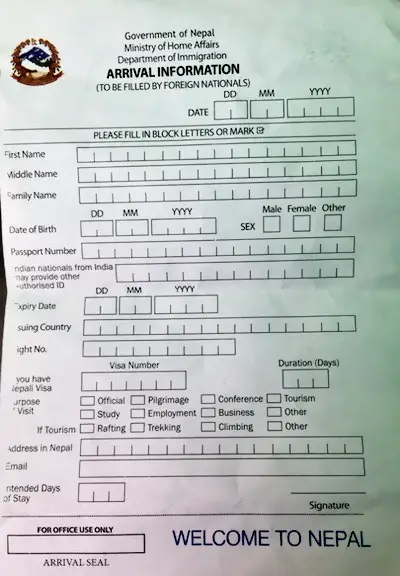
The final step in receiving the tourist visa is to proceed to the immigration desk with the following documents: Arrival card, the online form/form filled out at the kiosk, payment receipts, and your passport.
After you have completed these steps, you can proceed to immigration and collect your on arrival visa for Nepal.

Types of Visas in Nepal:
There are multiple types of visas available in Nepal. They include official, tourist, and business visas. If you are looking for more details regarding these three categories of visas in Nepal, please check the Ministry of Home Affairs, Department of Immigration official website .
For the majority of foreigners coming to Nepal, you will be getting a tourist visa on arrival. However, for individuals looking to get a different type of visa, you will need to work with the organization, business or university that will be sponsoring you.
It can be extremely difficult and time-consuming to get any other type of visa than a tourist visa. The best thing to do it to reach out to the massive expat Facebook group in Nepal . They can assist you with the process as some of the group members have gone through the visa process in Nepal before.
Visa Exemptions in Nepal
Most foreigners will require a visa while visiting Nepal. However, Nepal does have agreements with certain countries to allow their citizens to travel to Nepal without needing to purchase a visa. Moreover, these visa exemptions are typically given in the form of a Gratis Visa. Gratis Visas in Nepal are considered to be tourist visas as well.
Visa exemptions in Nepal include foreign nationals from the following countries:
All individuals that are exempt from paying for visas in Nepal will receive a tourist visa. However, if they wish to have a different visa type, they will still be required to pay the visa fee and show the required documents.
No matter if you receive a Gratis visa, a visa on arrival, or any other visa in Nepal, you will have to enter the country through one of the land border crossings, or from Tribhuvan International Airport in Kathmandu. The section below describes the different entry and exit points in Nepal.
Where Can I Get A Visa on Arrival?
Nepal is a landlocked country and currently has only one international airport operating (The Pokhara International Airport , only has limited flights currently). Therefore, if you wish to travel to Nepal you will have to enter by Tribhuvan International Airport in Kathmandu, or from one of the eight overland border crossings. To find out more about the different locations in Nepal, check out my blog Where is Nepal ?
The table shows the different visa entry points in Nepal listed from east to west starting with the international airport:
Overview Of The Nepal Visa:
This section provides an introduction to the key details you should be aware of about a Nepali visa.
1. What Is A Nepal Tourist Visa?
A Nepal tourist visa is extended to foreign citizens who intend to partake in tourism or leisure activities within Nepal. Irrespective of your purpose of visit, whether it involves mountaineering, trekking, or business, your initial entry into Nepal results in the issuance of a tourist visa.
Following your entry, you have the option to modify the visa category through the Nepal Department of Immigration to align with the specific purpose and duration of your stay. This adjustment depends on the underlying reason for your presence in Nepal. The different types of visas include: official, tourist, student and business.
2. What Is The Difference Between A Nepal Visa On Arrival And A Nepal Tourist Visa?
The Nepal Tourist Visa is the category of visa given to all international travelers entering Nepal. You apply for a Nepal Tourist Visa before departing for Nepal. On the other hand, the Nepal Visa On Arrival is the visa you receive at the airport upon your arrival. This process eliminates the need to secure a visa in advance of your Nepal travel.
3. Processing Time for Nepal Tourist Visa – US Citizens
The processing duration of the Nepal Tourist Visa varies based on the specific visa category you select. For instance, the Nepal Visa On Arrival application typically takes between 1 to 2 hours, depending on how busy the airport is. Conversely, if you choose to apply for a Nepal Tourist Visa through the Embassy, the processing time is estimated to be 3 to 5 business days, excluding weekends and public holidays.
4. Extending Your Nepal Tourist Visa:
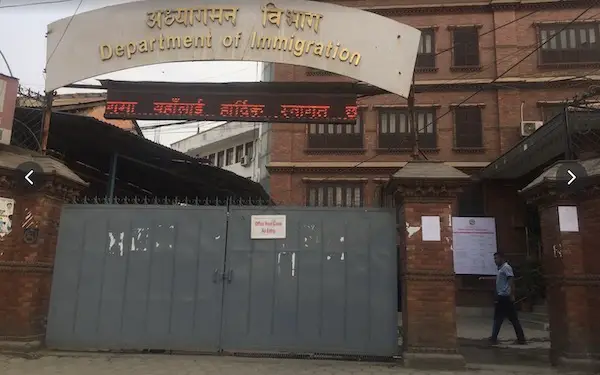
If you decide to extend your Nepal Visa, you can do so at the main office of the Government of Nepal’s Department of Immigration located in Kathmandu. This central office in Kathmandu is the sole authorized facility to handle extensions for both tourist and non-tourist visas.
It’s important to note that the Immigration Office in Pokhara has the authority to extend only tourist visas. Consequently, to avoid any issues, ensure you file for a visa extension before your Nepal visa expires. Failure to do so could lead to penalties for overstaying your visa, potential detainment, or even legal action. The extension for a tourist visa of up to 15 days requires a fee of USD 45. Afterward, an additional fee of USD 3 per day is applicable.
FAQs: Nepal Visas on Arrival
The following highlight some of the most frequently asked questions regarding visas in Nepal:
The price of a tourist visa in Nepal is USD $30 for 15 days, $50 for 30 days, and $125 for 90 days. Tourist visas can be extended to USD 3 per day. Tourists can stay in Nepal for a maximum of 150 days per calendar year.
Visas are required for all foreign nationals wanting to visit Nepal. Indian nationals are the only foreigners that do not need a visa. SAARC country nationals (except for Afghan nationals) as well as China, do not need to purchase a tourist visa and instead are given gratis visas on arrival.
Tourist visas are available in Nepal, and travel is open throughout the country. As of March 10, 2022, the Government of Nepal lifted all travel restrictions and allows travelers from all countries to arrive by land or air and receive a visa on arrival. Quarantine is not required as long as the person presents a negative test result.
Tourist visas can be purchased for USD $30: 15 days, $50: 30 days, and $125: 90 days. Tourist visas can be extended at USD 3 per day for a maximum of 150 days per calendar year.
Leave a Reply Cancel Reply
Your email address will not be published. Required fields are marked *
Add Comment *
Save my name, email, and website in this browser for the next time I comment.
Post Comment
Winter is here! Check out the winter wonderlands at these 5 amazing winter destinations in Montana
- Travel Tips
How To Apply For A Nepal Visa On Arrival (For Tourists)
Published: September 10, 2023
Modified: January 3, 2024
by Verla Dobson
- Plan Your Trip
- Travel Destinations
- Travel Essentials & Accessories
- Travel Guide
Introduction
Welcome to Nepal, a land of natural beauty, rich culture, and adventure. If you’re planning a trip to this captivating country, one of the first things you’ll need to do is apply for a visa. Fortunately, Nepal offers a convenient visa on arrival process for tourists entering the country by air or land.
Obtaining a Nepal visa on arrival is a straightforward process that allows you to obtain a visa upon your arrival at Tribhuvan International Airport in Kathmandu or other border entry points. This eliminates the need to go through the lengthy process of applying for a visa at a Nepali embassy or consulate in your home country.
In this article, we will guide you through the step-by-step process of applying for a Nepal visa on arrival. We will provide you with all the necessary information and tips to ensure a smooth and hassle-free experience.
So, whether you’re planning a trekking adventure in the Himalayas, exploring ancient temples and palaces, or immersing yourself in the unique cultural heritage of Nepal , let’s dive into the process of obtaining a Nepal visa on arrival.
Step 1: Check Eligibility for Visa on Arrival
Before you start preparing for your Nepal visa on arrival, it’s essential to ensure that you meet the eligibility criteria. The visa on arrival is available for citizens of most countries, except for a few exceptions.
To check if you are eligible for a Nepal visa on arrival, you can visit the official website of the Department of Immigration of Nepal or consult with your local Nepali embassy or consulate. They will provide you with the most accurate and up-to-date information regarding visa requirements.
It’s important to note that the visa on arrival is primarily meant for tourist purposes and has certain limitations. If you are planning to work, study, or engage in any other non-touristic activities in Nepal, you may need to apply for a different type of visa in advance.
Some nationalities may also require additional permits for specific regions or activities in Nepal, such as trekking in restricted areas. It’s crucial to research and understand these requirements before your trip to avoid any complications or delays.
It’s also worth mentioning that the visa on arrival is usually issued for a maximum stay of 15, 30, or 90 days. The duration varies depending on your nationality and the purpose of your visit. If you wish to extend your stay in Nepal, you can do so by applying for an extension at the Department of Immigration in Kathmandu.
Once you have confirmed your eligibility and understand the visa requirements, you can proceed to the next step of gathering the necessary documents for your Nepal visa on arrival.
Step 2: Gather Required Documents
Before traveling to Nepal, it’s important to gather all the required documents for your visa on arrival. Having the necessary documents ready will streamline the process and prevent any delays or complications at the immigration counter.
The documents you will need for your Nepal visa on arrival include:
- A valid passport: Ensure that your passport is valid for at least six months from the date of your arrival in Nepal. It should also have at least one blank page for the visa sticker.
- Completed visa application form: You can obtain the application form at the immigration counter upon arrival or download it in advance from the official website of the Department of Immigration. Fill out the form with accurate and truthful information.
- Passport-sized photos: Carry at least two recent, color passport-sized photographs (size: 1.5 x 1.5 inches) with a white background. These photos will be affixed to your visa application form.
- Visa fee: Prepare the appropriate amount of cash in USD or the local currency (Nepalese Rupees) to pay for the visa fee. The fee varies based on the duration of your stay in Nepal, so it’s advisable to have the exact amount ready.
- Additional documents: Depending on your specific circumstances, you may be required to provide additional documents. For example, if you are visiting Nepal for a volunteer program, you might need a letter of sponsorship or invitation from the organization hosting you.
It’s always recommended to carry copies of important documents, such as your passport data page and travel insurance, as well as any supporting documents relevant to your visit to Nepal. These copies can come in handy in case of loss or emergency.
By ensuring you have all the necessary documents prepared in advance, you’ll be well-prepared to proceed with the visa application process upon your arrival in Nepal.
Step 3: Travel to Nepal
After confirming your eligibility and gathering the required documents, the next step is to make travel arrangements to Nepal. Whether you plan to fly into Kathmandu or enter via a land border, ensuring smooth travel will help set the stage for a stress-free visa on arrival experience.
If you’re traveling by air, you’ll most likely arrive at Tribhuvan International Airport in Kathmandu, the capital city of Nepal. Many international airlines have direct flights to Kathmandu from major cities around the world. It’s a good idea to book your flights well in advance to secure the best fares and convenient travel times.
If you’re entering Nepal by land, you can choose one of the several entry points along the Nepal-India or Nepal-China border. These include Sunauli-Bhairawa, Kakarbhitta, Birgunj, and Mahendranagar, among others. Make sure to check the availability and operating hours of these border crossings before planning your trip.
Additionally, it’s crucial to review any travel advisories or entry requirements issued by your home country’s government regarding travel to Nepal. Stay informed about the latest updates and ensure that you comply with any health, safety, or security guidelines.
When planning your travel, take into consideration the weather conditions and peak tourist seasons in Nepal. The country experiences unique climatic variations across its diverse landscapes and regions, so make sure to pack accordingly and be prepared for the prevailing weather during your visit.
Lastly, consider arranging your accommodation and transportation within Nepal in advance to avoid any last-minute hassle. Nepal offers a wide range of accommodation options, from budget-friendly guesthouses to luxurious hotels, depending on your preferences and budget.
By planning your travel to Nepal with care and keeping in mind important considerations, you’ll be well-prepared for a smooth and enjoyable visa on arrival experience.
Step 4: Arrival at Nepal Airport
Congratulations, you have arrived in Nepal! As you disembark from your flight and make your way through Tribhuvan International Airport in Kathmandu, there are a few things to keep in mind to ensure a seamless visa on arrival process.
Once you enter the airport, follow the signs for immigration and head towards the immigration area. It’s advisable to go directly to the visa on arrival counter to avoid any unnecessary delays.
At the visa on arrival counter, you will find immigration officers who will process your visa application. This is where you will submit your completed visa application form, along with your passport, passport-sized photos, and visa fee in the specified currency (USD or Nepalese Rupees).
The immigration officers may ask you a few questions about your visit to Nepal, such as the purpose of your trip, duration of stay, and your travel plans. Be prepared to answer these questions confidently and truthfully.
It’s worth noting that during peak travel seasons, there may be a queue at the visa on arrival counter. While waiting, take this time to fill out the arrival card, which will be provided to you at the airport.
Make sure to keep your boarding pass or e-ticket handy, as sometimes you may be asked to present it along with your passport and visa application form. Also, remember to keep your documents and valuables safe during this process.
Once your visa application has been processed and approved, the immigration officer will attach a visa sticker to your passport. This sticker serves as your official visa to enter and stay in Nepal for the prescribed duration.
Now that you have successfully obtained your Nepal visa on arrival, it’s time to proceed to the immigration process and enter this beautiful country. Follow the instructions of the immigration officers and obey any immigration rules and regulations.
With the visa sticker in your passport, you are now ready to explore the wonders of Nepal. Remember to keep your passport and visa documents secure throughout your stay in the country.
Continue to the next step to learn about filling out the arrival card, an important document required upon your arrival in Nepal.
Step 5: Filling out the Arrival Card
After obtaining your Nepal visa on arrival, the next step is to fill out the arrival card. This is an important document required by the immigration authorities upon your arrival in Nepal. The arrival card collects essential information about your travel and stay in Nepal.
Upon your arrival at Tribhuvan International Airport or other border entry points, you will be given the arrival card by the immigration staff. The card is typically provided along with your visa application form, or it may be available at a separate counter. You can also download and print the arrival card in advance from the official website of the Department of Immigration.
To fill out the arrival card, follow these steps:
- Title: Write your title, such as Mr., Mrs., or Miss, in the designated field.
- Full Name: Enter your full name as it appears in your passport.
- Date of Birth: Write your date of birth in the format of day-month-year.
- Nationality: Mention your nationality, which should match the country of your passport.
- Passport Number: Enter your passport number. Ensure that you enter it correctly to avoid any discrepancies.
- Occupation: State your occupation or profession, such as student, engineer, teacher, or any other relevant occupation.
- Flight Number: If you are arriving by air, provide the flight number of your arriving flight. If you are entering by land, you can leave this field blank.
- Address in Nepal: Write the address of your place of stay in Nepal, such as the hotel, guesthouse, or the home address of your local host.
- Purpose of Visit: Indicate the purpose of your visit to Nepal, whether it’s tourism, business, work, study, or any other purpose.
- Duration of Stay: Specify the number of days or the intended duration of your stay in Nepal.
- Sign and Date: After completing the arrival card form, sign your name and write the current date in the respective fields.
Ensure that you provide accurate and truthful information while filling out the arrival card. It’s important to double-check all the details before submitting the form to the immigration officer.
Once you have filled out the arrival card, submit it along with your passport and visa documents to the immigration officer for further processing. The officer will stamp your passport and return the necessary documents to you.
Filling out the arrival card accurately and efficiently will save you time and ensure a smooth transition through the immigration process, allowing you to proceed with your exploration of Nepal without any delay.
Step 6: Paying Visa Fee
After completing the visa application and arrival card, the next step in the Nepal visa on arrival process is paying the visa fee. The visa fee varies based on the duration of your stay in Nepal and can be paid in either US dollars or Nepalese Rupees. It’s important to have the exact amount ready to avoid any inconvenience.
When you approach the visa on arrival counter at the airport or land border entry point, the immigration officer will inform you of the visa fee applicable based on your nationality and the duration of your stay. The fee may be different for single-entry and multiple-entry visas.
The visa fee can usually be paid in cash, so make sure to have the exact amount available. If you prefer to pay in a currency other than US dollars, it’s advisable to exchange some money beforehand, either at the airport or at a local currency exchange facility.
It’s important to note that credit or debit card payments may not be accepted for visa fees at the visa on arrival counters. Therefore, it’s recommended to carry sufficient cash in the appropriate currency to cover the visa fee.
While paying the visa fee, be sure to count the amount correctly and hand it over to the immigration officer. They will verify the payment and issue you a receipt for the visa fee.
Keep the receipt safely as proof of payment throughout your stay in Nepal. The receipt may be required for certain activities, such as extending your visa or obtaining permits for restricted areas.
By having the visa fee amount ready and being prepared to pay in the accepted currency, you can quickly and efficiently complete this step of the visa on arrival process in Nepal.
Step 7: Immigration Process
Once you have completed the necessary paperwork and paid the visa fee, you will proceed to the immigration process. This step involves having your passport and visa documents checked and stamped by the immigration officers.
At the immigration counter, present your passport, visa application form, arrival card, and the receipt of the visa fee payment to the immigration officer. They will verify the information and ensure that all the required documents are in order.
The immigration officer may ask you a few questions regarding your trip, such as the purpose of your visit, the duration of your stay, and your accommodation details. Answer the questions honestly and confidently.
The officer will then stamp your passport with the entry seal, indicating your arrival date and the duration of your visa validity. Verify the accuracy of the information on the entry seal before leaving the counter.
Once your passport has been stamped, it is essential to check that all your documents have been returned to you. Ensure that you have received back your passport, visa sticker, arrival card, and the receipt for the visa fee payment.
It’s important to keep your passport and visa documents in a safe and secure place throughout your stay in Nepal. Carry them with you when traveling within the country and be prepared to show them when required, such as during hotel check-ins or when dealing with local authorities.
With the completion of the immigration process, you are now officially cleared to enter Nepal. You can collect your belongings and proceed to explore the beautiful landscapes, vibrant culture, and warm hospitality that Nepal has to offer.
Remember to follow all rules and regulations during your stay in Nepal, and respect the local customs and traditions. Enjoy your time in this enchanting country and make lasting memories.
Step 8: Collect Visa Sticker
Once you have completed the immigration process and received the entry stamp on your passport, the last step of the Nepal visa on arrival process is to collect your visa sticker. The visa sticker serves as proof of your authorized stay in Nepal and should be affixed to your passport.
After exiting the immigration area, take a moment to carefully examine your passport and ensure that the visa sticker has been placed correctly. The visa sticker contains important information such as your name, visa type, duration of stay, and the date of issuance.
Make sure that all the details on the visa sticker accurately reflect the information you provided during the application process. If you notice any errors or discrepancies, promptly notify the immigration officers or staff at the airport for correction.
It’s important to handle your passport with care and keep it in a secure place throughout your stay in Nepal. The visa sticker should not be tampered with or removed under any circumstances.
During your time in Nepal, local authorities or accommodation providers may request to see your visa sticker. It’s recommended to carry a photocopy of your passport with the visa sticker page, while keeping the actual passport safely stored.
If you plan to extend your stay in Nepal, you can apply for a visa extension at the Department of Immigration in Kathmandu or its regional offices. Make sure to initiate the extension process well before your current visa expires to avoid any penalties or legal issues.
Remember, it is your responsibility to comply with all immigration laws and regulations while in Nepal. Failure to do so may result in fines, deportation, or other legal consequences.
With your visa sticker in place, you are now ready to make the most of your time in Nepal. Immerse yourself in the breathtaking landscapes, vibrant culture, and warm hospitality that this remarkable country has to offer.
Enjoy your journey, and may your time in Nepal be filled with incredible experiences and unforgettable memories!
Congratulations! You have successfully navigated the process of applying for a Nepal visa on arrival. This hassle-free and convenient option allows you to obtain your visa upon arrival at the airport or land border entry points, eliminating the need for prior visa applications at Nepali embassies or consulates in your home country.
In this comprehensive guide, we have walked you through the step-by-step process to ensure a smooth visa on arrival experience. We covered everything from checking your eligibility and gathering the required documents to traveling to Nepal and completing the immigration process.
By following these steps, you can confidently arrive in Nepal and explore all that this incredible country has to offer. From the majestic peaks of the Himalayas to the ancient temples and vibrant cultural heritage, Nepal is a treasure trove of natural beauty and cultural wonders.
Remember to check the eligibility criteria before your trip, gather all the necessary documents, and carefully fill out the arrival card. Be prepared to pay the visa fee in the local currency, and ensure a smooth immigration process by providing accurate information and complying with the rules and regulations.
As you embark on your Nepalese adventure, always carry your passport with the visa sticker securely, along with any other important documents. Respect the local culture, customs, and regulations, and make the most of your stay in Nepal.
Whether you’re planning to trek through the Himalayas, immerse yourself in the rich spiritual heritage, or simply enjoy the breathtaking landscapes, Nepal offers a truly unforgettable experience.
So, pack your bags, prepare for an incredible journey, and get ready to create cherished memories in the mesmerizing land of Nepal.
Have a fantastic trip!

- Privacy Overview
- Strictly Necessary Cookies
This website uses cookies so that we can provide you with the best user experience possible. Cookie information is stored in your browser and performs functions such as recognising you when you return to our website and helping our team to understand which sections of the website you find most interesting and useful.
Strictly Necessary Cookie should be enabled at all times so that we can save your preferences for cookie settings.
If you disable this cookie, we will not be able to save your preferences. This means that every time you visit this website you will need to enable or disable cookies again.

गृह मन्त्रालय
अध्यागमन विभाग.
कालिकास्थान, काठमाडौँ
- अन अराइभल भिषा
अन अराइभल भिषा 2074-11-18
अध्यागमन विभाग अन्तर्गतका ९ वटा प्रवेश तथा प्रस्थान बिन्दु(अध्यागमन कार्यालयहरु) बाट आगमन पश्चात् On Arrival भिषा प्राप्त गर्न सकिने ब्यवस्था गरिएको छ। हवाई उडानबाट नेपाल प्रवेश गर्नेको लागि अध्यागमन कार्यालय, त्रि. अ. वि. मार्फत् आवश्यक ब्यवस्था मिलाएको छ भने मैदानबाट नेपाल प्रवेश गर्ने बिदेशीको हकमा सीमा क्षेत्रमा स्थापित अध्यागमन कार्यालयहरुले पर्यटक भिषा जारी गर्ने ब्यवस्था मिलाउँदै आएका छन्। प्रवेश बिन्दुबाट जारी गरिने सबै भिषा पर्यटक भिषा हुन्।
यस भिषा प्राप्त गर्ने प्रकृया अत्यन्तै सरल छ। भिषाको लागि अनलाइन फारम (पर्यटक भिषा) भर्नुहोस्। फारम भर्न अध्यागमन विभागको वेभसाइटमा जान सक्नुहुन्छ।उक्त फारमले १५ दिनसम्म मात्र काम गर्दछ।फारम धेरै चाँडै नभर्नुहोला। अथवा अध्यागमन कार्यालय त्रि अ वि मा पनि फारम भर्न kiosk मेसिन राखिएका छन्। उक्त मेशिनको सहायताले फारम भर्न सकिन्छ। भिषाको लागि तोकिएको दस्तुर बैँकमा बुझाउनुहोस् र अनलाइन फारम, बैंकमा पैसा तिरेको भौँचर सहित अध्यागमन अधिकृत रहेको भिषा डेस्कमा जानुहोस्। अध्यागमन अधिकृतले तपाईका कागजात छानबिन गरि तपाईलाई नेपालमा प्रवेश दिन उपयुक्त देखेमा पर्यटक भिषा जारी गर्नेछन्।

1. Obtaining Visa:
All foreign nationals, except Indians, are required to have a valid visa to enter Nepal. Documents can be submitted to Embassy through post or in person.
Requirements for tourist visa include:
- Visa application form. Fill up and print out print out from https://nepaliport.immigration.gov.np/onlinevisa-mission/application
- Copy of Valid passport with a minimum of six-month validity period at the time of entry into Nepal.
- In case of sending documents via post, Money Order/Bank Cheque or required amount made in the name of ‘Embassy of Nepal’. And,
- Self-addressed postage paid express envelop. The Embassy will not be responsible for lost/undelivered posts. ( Postal Address: Embassy of Nepal, PO box no 1070, Mawson, ACT 2607 ) It is strongly advised not to send Cash.
- In case of Travel Document holder, also include Sponsor Letter from Nepal and an application explaining your reason to travel Nepal.
- Visa can be obtained by visiting Embassy in person on any office day. Document Submission Time: 9am-12pm, Visa Collection Time: 3pm-5pm.
Visa once issued cannot be withdrawn, visa fee cannot be refunded after visa is issued, and it must be used within six months from the date of issue.
2. Visa Fee
Note :- The visa fee charged by the Honorary Consulates may be higher than the above due to service fee they charge for the services rendered. Please contact them or visit their website for further information.
3. On Arrival Visa:
Nationals from most of the countries including Australia and New Zealand can get On-Arrival Visa in Kathmandu. Please be advised that Visa Pre-arrival form should be completed through https://nepaliport.immigration.gov.np/ before boarding
Tourist entry visa can also be obtained at the following immigration offices in Nepal:
- Immigration Office, Tribhuvan International Airport, Kathmandu
- Immigration Office, Kakarvitta, Jhapa (Eastern Nepal)
- Immigration Office, Birgunj, Parsa (Central Nepal)
- Immigration Office, Kodari, Sindhupalchowk (Northern Border)
- Immigration Office, Belahia, Bhairahawa (Rupandehi, Western Nepal)
- Immigration Office, Jamunaha, Nepalgunj (Banke, Mid Western Nepal)
- Immigration Office, Mohana, Dhangadhi (Kailali, Far Western Nepal)
- Immigration Office, Gadda Chauki, Mahendranagar (Kanchanpur, Far Western Nepal)
4 . People of these countries can not get visa on arrival at the immigration entry point of Nepal. Please contact the nearest Nepalese Embassy, Consulate Office and get further information.
5 . Visa Year : January to December
6 . Visa Extension
A tourist visa can be extended up to 120 days within a visa year from the Department of Immigration in Kathmandu and Pokhara Immigration Office on request. Thereafter an additional 30 days can be extended from Department of Immigration, Kathmandu ensuring that tourist visa cannot be extended more than 150 days.
7. Gratis visa and eligibility:
- Diplomatic Visa
Eligibility: Diplomatic Passport holders and their family members. Duration : Reciprocal basis( in the recommendation of their respective Diplomatic Missions). Issuing Authority: Ministry of Foreign Affairs. For 30 days entry-Embassies and the Immigration Office at the entry points in Nepal. A note verbale from the concerned Diplomatic Mission or Ministry of Foreign Affairs is required.
- Official Visa
Eligibility: Non-Diplomatic personnel of Missions and their family Members, Honorary/Nepalese Consulate Generals/Consuls and their family members(during the time of their visit to Nepal), Advisers and Specialists, working in Nepal under the official agreement and their family members, UN Agencies personnel, UN document holders and their family members, Personnel working in the International institutions or Regional Organizations in Nepal and their family members. Requirement: A note verbale from the concerned diplomatic mission. Issuing Authority: Ministry of Foreign Affairs. For 30 days entry-Embassies and the Immigration Office at the entry points in Nepal.
8. Children below the age of ten years shall be exempted from visa fees ; no visa fee shall be applicable to the Chinese passport holder upto 150 days and to the passport holder of member states of the South Asian Association for Regional Cooperation (SAARC) for 30 days
- Embassy issues Tourist, Diplomatic and Official Visa only. People going for other purposes can obtain a tourist visa from the Embassy or Consulate and apply for an appropriate category at the Department of Immigration, Nepal with required eligibility & documents or submit visa application online and get approval before traveling to Nepal. For detailed information on visa and other related information please contact:
Department of Immigration Kalikasthan, Dillibazar Kathmandu. Tel: +977-1-4429659/4429660/4438862/4438868 Fax: +977-1-4433934/4433935 Email: [email protected] www.nepalimmigration.gov.np
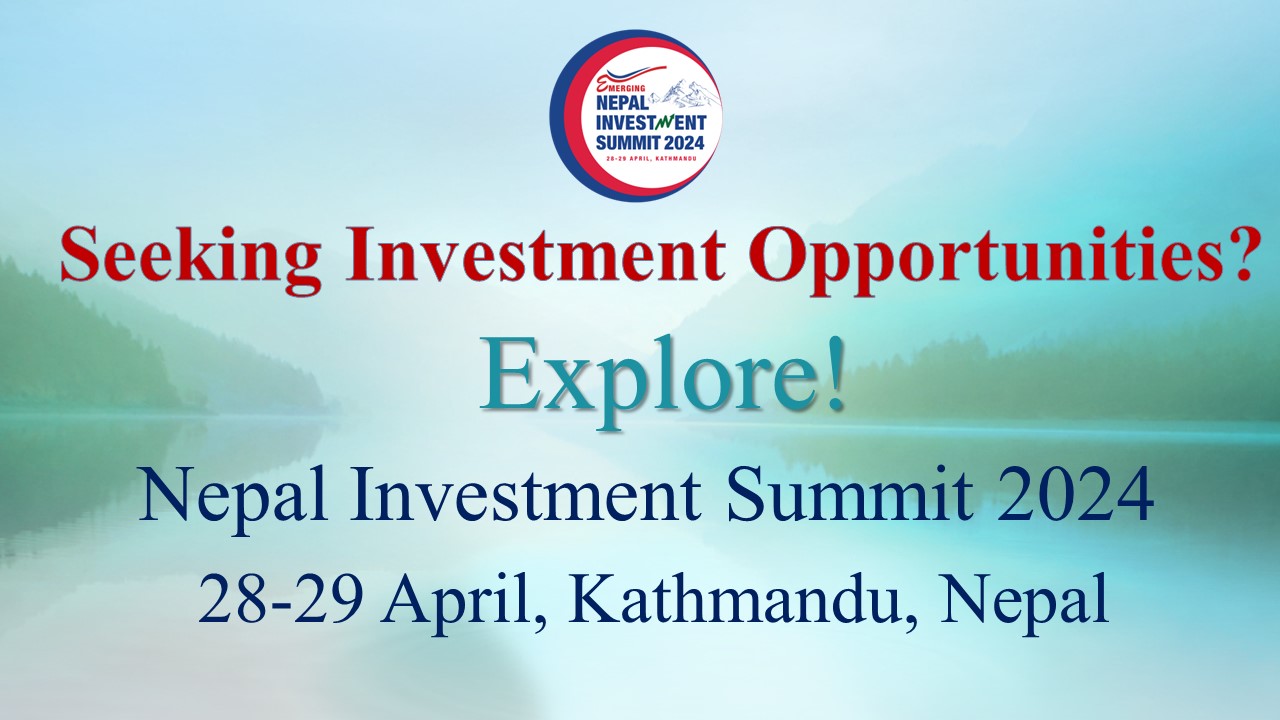
This is not for e-passport booking.
Please click on https://au.nepalembassy.gov.np/passport/ for e-passport booking
———————————
Please make sure to book the appointment under the correct service category. Embassy will not be able to provide the service if the appointment is booked under different category regardless of any circumstances. Further, be advised that the service duration is indicative only. Thank you !
Remember to reschedule / cancel the appointment if unable to attend / no longer required .

Visa for Nepal in the UAE
If you plan to visit Nepal, please come to the Embassy of Nepal in Abu Dhabi with the following documents:
- Kindly submit online application for the visa through the following link: https://nepaliport.immigration.gov.np/onlinevisa-mission/application
- Please bring the printed copy of the visa application form generated online after submission.
- Your Passport and its photocopy (Please note that the validity of your passport shouldn’t be less than six months, and there should be at least one blank page to stamp visa in your passport)
- A copy of your UAE resident visa,
- NOC Letter (No Objection Letter) from your sponsor/Company (if your are employed in the UAE). The letter either can be addressed to the embassy or simply written as “To Whom It May Concern” type that mentions inter alia their No Objection to the employe’s visit, the employee’s name and nationality, job title and salary. The letter should be stamped and signed by the company’s autorized person. Passport copy with UAE Visa page copy of the sponsor is required in case of personal sponsorship.
- Any other document that you think supports your application.
- Visa fee in cash.
- Please be advised to come to the Embassy in person to apply for a visa. Applicant(s) can also authorize somebody to act on his/her behalf to submit the application and collect the passport/visa. Also note that a person himself/herself an applicant can represent Group travelers or families and apply on their/his/her behalf but cannot sign on their/his/her behalf in the applications.
- Visas applications can be submitted between 9:30 am to 1.30 pm (from Monday to Friday) and can be collected between 2:30 to 4 pm.
- Please note that visa policies could be different for different nationalities. To learn more visit www.nepalimmigration.gov.np
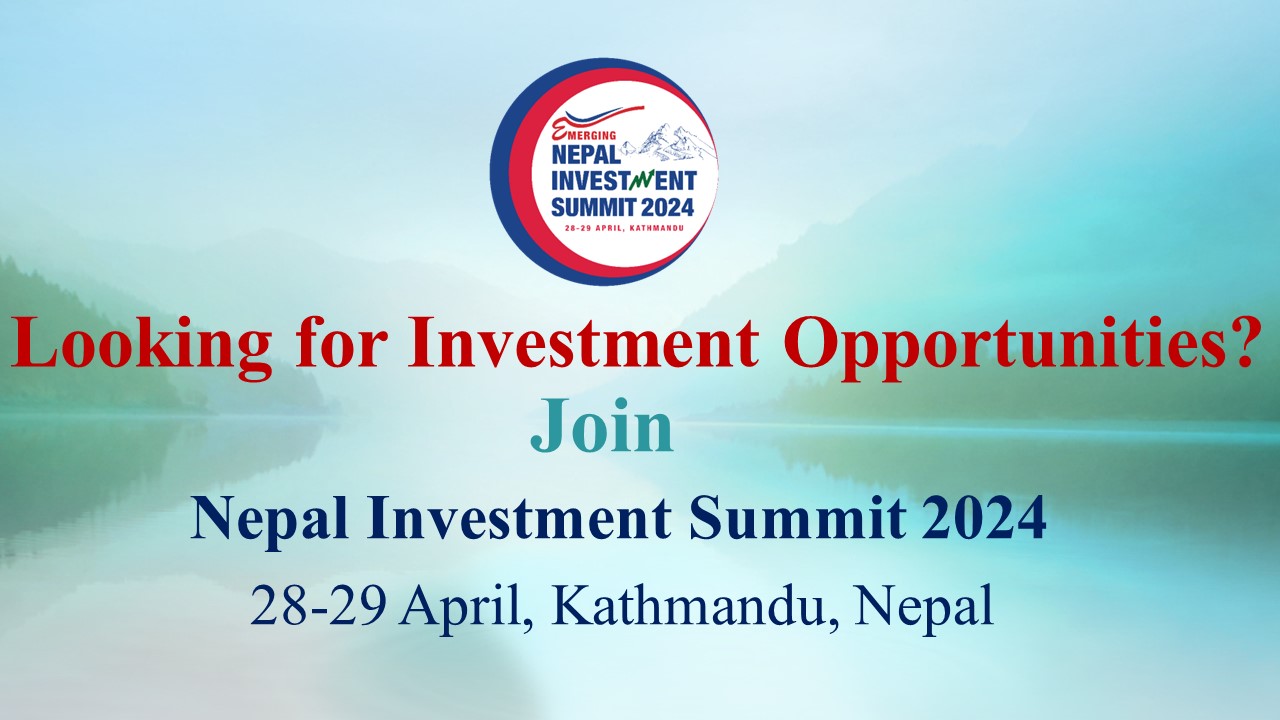

Tourist Visa Application
Complete “Online Visa Application” HERE
A. Documents to be submitted for Tourist Visa:
- The printed copy of the “Online Visa Application” confirmation page
- Original Passport with at least 6 months of validity
- Visa fee in the form of Money Order or Bank Draft in the name of the Embassy of Nepal, Ottawa. Applicants submitting visa application in person may pay the fee by debit card too.
- A prepaid self-addressed express return envelope with tracking number
Additional Documents Required For a Travel Document Holder
- Sponsorship Letter from a Nepali Citizen addressed to the Embassy of Nepal, Ottawa.
- A copy of the citizenship certificate of the sponsor.
Documents must be sent by mail/post to the following address:
Embassy of Nepal 408 Queen Street Ottawa, Ontario K1R 5A7
B. Visa Fee:
- 15 days Multiple Entry Tourist Visa – CAD 45.00
- 30 days Multiple Entry Tourist Visa – CAD 70.00
- 90 days Multiple Entry Tourist Visa – CAD 180.00
C. Application Processing Time:
Normally 1-4 business days
(However, incomplete application or other reasons may delay the processing time)
Note: 1. Children below 10 years of age are issued Free Visas (Gratis Visas) 2. Personal Cheques, Credit Cards or online bank transfers are NOT acceptable. 3. Visa once issued cannot be withdrawn nor the visa fee be refunded. Visa must be used within six months from the date of issue. 4. Application will be returned if the required documents are not complete. 5. For more Immigration and Tourism information please visit www.nepalimmigration.gov.np , www.tourism.gov.np and www.ntb.gov.np
Back to Visas
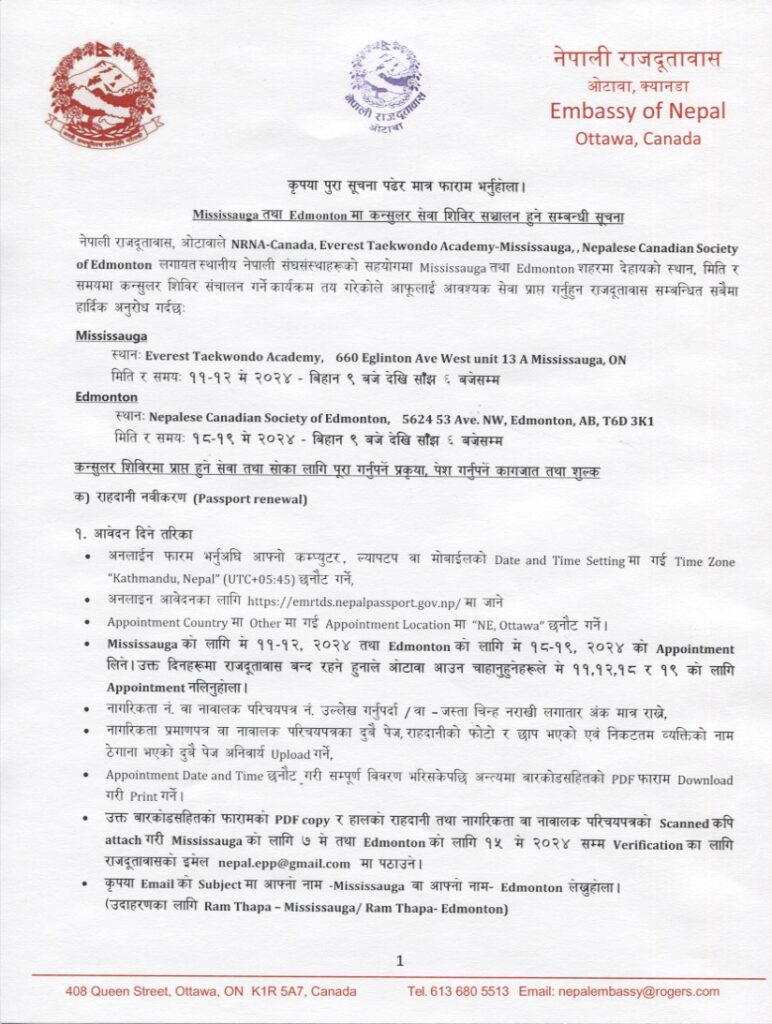
Is this your first time applying for a visa and/or visiting our site?
भाषा परिवर्तन: Change to Nepali
Apply for a U.S. Visa
Effective May 1, 2024, the premium delivery charges have been revised to NPR. 650- per passport/document for all U.S. Visa applicants, payable in cash on the NIMB Cash counter of the Premium Delivery locations. Please refer to our website for additional details.
Select here to learn more about an important update on waivers of the interview requirement for certain nonimmigrant visa applicants.
(Updated: October 11, 2023)
All receipts for payment of Machine-Readable Visa (MRV) fees issued before October 1, 2022, expired September 30, 2023. There will be no extensions of fee validity. Applicants must have scheduled an appointment or submitted an interview waiver application before September 30, 2023 to avoid paying a new fee. If you paid the MRV fee on or after October 1, 2022, you must have scheduled the appointment within one year of your MRV payment date. Please note that the interview itself does not need to take place within one year, but an interview appointment needs to be made in the system, even if it is scheduled months into the future. Furthermore, applicants using MRV fees paid before October 1, 2022 to book an appointment are cautioned not to attempt to change their appointment dates on or after October 1, 2023. Doing so will result in forfeiture of both the original appointment slot and the MRV fee receipt. The applicant will be required to pay a new fee and submit a new application package.
Nonimmigrant visa holder travel: Passengers no longer need to show proof of being fully vaccinated with an accepted COVID-19 vaccine to board a flight to the United States. For more information, visit https://wwwnc.cdc.gov/travel/page/before-travel .
Immigrant visa applicants: U.S. immigration law requires immigrant visa applicants to obtain certain vaccinations prior to the issuance of an immigrant visa. For more information visit https://travel.state.gov/content/travel/en/us-visas/immigrate/vaccinations.html .
For the latest information from the U.S. Department of State regarding visa issues and travel to the United States, please visit: https://travel.state.gov/content/travel/en/News/visas-news.html .
Your interview date can be scheduled within 365 days from the start of your program shown on the form I-20. However, if your visa is approved, you cannot enter the United States more than 30 days in advance of the date shown on the form I-20. Your initial entry to the United States must be to attend the same school annotated on your visa. The immigration inspector at the port of entry (POE) can refuse admission for a student seeking an initial entry with a Form I-20 from a school other than the one named on the visa or if the student indicates an intention to attend a different institution.
Applicants at Nepal can now pay the Machine Readable Visa (MRV) fee through electronic funds transfer (EFT) payment option using connectIPS e-Payment System. Although fees are listed in U.S. dollars, payment must be made using local currency (NPR). No debit/credit cards will be accepted in order to pay the MRV fee . For more information, please visit this link .
The Consular Exchange Rate is periodically revised based on the prevailing conversion rate. Before submitting your payment, please verify that the visa fee on your deposit slip matches the current consular exchange rate listed on the visa fee page .

Welcome to the U.S. Visa Information Service for Nepal. On this website you can find information about U.S. immigrant and nonimmigrant visas and the requirements to apply for each. You can also learn how to pay the required visa application fee, and book an interview appointment at the U.S. Embassy Kathmandu, Nepal
This is the official visa information website of the U.S. Mission in Nepal.
Nonimmigrant Visa Information
- Bank and Payment Options
- Form DS-160 Information
- Appointment Wait Times
- Photos and Fingerprints
- Visa Waiver Program
- Security Regulations
Nonimmigrant Visa Application
- Apply for a Visa
- Pay My Visa Fee
- Complete My DS-160
- Schedule My Appointment
- Track My Passport
- Apply for an Expedited Appointment
- Interview Waiver & Visa Renewal
- Application Refused Under INA 221(g)
- Immigrant Visa Information
- K Visa Applicants
- Expedited & Medical Hold Cases
- Health Workers and Employment-Based Immigrant Visa
- Reschedule My Immigrant / Diversity Visa Appointment
- Check My Immigrant Visa Petition Status
- Immigrant Visa Wait Times
- Track & Retrieve My Passport
Local Visa Programs
- Travel Coordinator
- Group Appointments
- Diplomatic and Government Officials
- Applicants under 14 years of age or age 80 and over
- U.S. Embassy
- Passport/Visa Collection Locations and Drop-off Locations
- Bank Locations
General Information
- Frequently Asked Questions
- Holidays and Closures
- Rights and Protections
- Helpful Links
© CGI Federal Inc.
Department of State
- usvisas.state.gov
- Culture & Lifestyle

- Madhesh Province
- Lumbini Province
- Bagmati Province
- National Security
- Koshi Province
- Gandaki Province
- Karnali Province
- Sudurpaschim Province
- International Sports
- Brunch with the Post
- Life & Style
- Entertainment
- Investigations
- Climate & Environment
- Science & Technology
- Visual Stories
- Crosswords & Sudoku
- Corrections
- Letters to the Editor
- Today's ePaper
Without Fear or Favour UNWIND IN STYLE

What's News :
- Court ruling on fake news
- Drones to transport garbage from Everest
- Nepal Investment Summit
- KMC waste segregation
- Becoming adults
China exempts regular visa fee for Nepali travellers

Post Report
China has announced exempting visa fees for Nepali travellers with effect from May 1.
In order to promote the friendship and further facilitate the personnel exchange between China and Nepal, visa fees will not be charged from May 1, the Chinese Embassy in Kathmandu said in a statement on Sunday.
The exemption will apply to regular visa processing. However, express fees and service fees will be charged, according to the embassy.
Nepal had been requesting the northern neighbour to exempt visa fees for a long time. Deputy Prime Minister and Minister for Foreign Affairs Narayan Kaji Shrestha during his visit to China last month had requested the Chinese authorities to exempt visa fees.
Nepal has been waiving visa fees for Chinese nationals since 2016 and has been looking for reciprocal treatment from China.
Related News

Regulatory void complicates child adoption process in Nepal

Japan foreign minister visiting to widen scope of bilateral ties
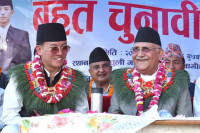
Ilam bypoll: Fillip for old parties, reality check for RSP
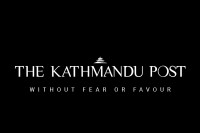
Man injured in tiger attack

Special Court acquits sitting, ex-Pashupati officials of corruption
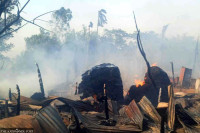
Inferno guts over 200 homes in Saptari
Most read from national.
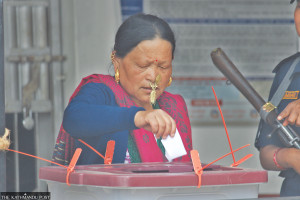
Polling peaceful in Ilam, Bajhang

Suhang Nembang takes lead in Ilam-2
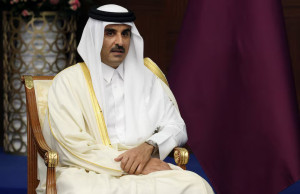
Five MoUs to be signed during Qatar emir’s visit

Qatari Emir Al-Thani arriving on two-day Nepal visit
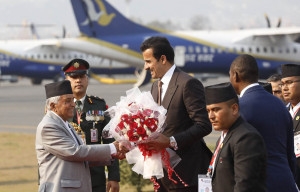
Qatar’s Emir Al-Thani arrives in Kathmandu on two-day visit
Editor's picks.
.jpg&w=300&height=200)
Nepal sets sight on multi-billion dollar LGBTIQ tourism market
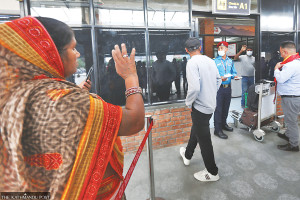
Escalating Middle East crisis threatens Nepali economy

Laws on marital rape still murky in Nepal
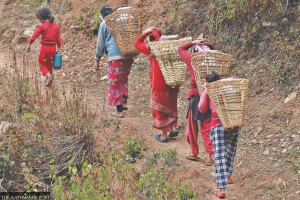
As springs dry up, water shortage deepens in high altitude villages of Mallarani in Pyuthan
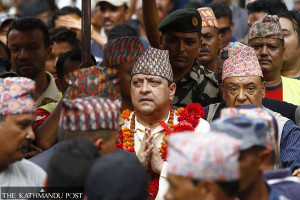
Melodrama for monarchy
E-paper | may 01, 2024.
- Read ePaper Online

IMAGES
VIDEO
COMMENTS
On Arrival Visa Fee at Entry Points. 15 Days - 30 USD. 30 Days - 50 USD. 90 Days - 125 USD. 3rd Step Proceed to the Immigration Desk with your online form, payment receipts and your passport; Hand in your documents to immigration officer for visa processing. He/she issues visa to you upon his/her satisfaction. Visa Extension Fee
Immigration Offices, under Department of Immigration have been facilitating tourists flying to Nepal by providing Visa on Arrival. 'On Arrival' visa procedure is very quick and simple. You can expect some queues during peak Tourist season. If you wish to skip those queues, you can also consider getting...
Hand in your documents to immigration officer for visa processing. He/she issues visa to you upon his/her satisfaction. Visa Extension Fee . Tourist visa extension is done for minimum 15 days with USD 45 and USD 3 per day for additional days. In the case of delay less than 150 days additional USD 5 per day as late fine. Gratis Visa (Visa for Free)
Understanding the Tourist Visa Application Process. Applying a tourist visa for Nepal might seem daunting, but with the right information, the process becomes much smoother. The process involves several steps, including filling out the application form, gathering necessary documents, and submitting your application to the appropriate authorities.
A Nepal Tourist Visa is the type of visa issued to all foreigners who enter Nepal. A Nepal Visa On Arrival is one of the ways through which you can apply for a Nepal Tourist Visa - so, by default, the Visa On Arrival is a Tourist Visa. However, the difference is that a Nepal Tourist Visa can also be obtained from one of the Nepalese ...
The processing time for the Nepal Tourist visa will vary depending on the applicant's nationality and the method of submission. Approved Visa Applications Visa on arrival. After presenting the required documents to the immigration officer, travelers will receive a decision on the spot. If the Tourist visa is approved at the airport, the ...
If the application is made by post, the processing time is 3 working days. Card Payment (Visa Debit/Credit, Master Card Debit/Credit, All Maestro cards) is accepted for the payment of visa fees. ... Over the course of a visa year, a tourist cannot stay in Nepal more than cumulative 150 days. Non-Residential Nepalese Visa:
Non-tourist visa issuance has been known to take months to process and stays beyond 150 days on a tourist visa will lead to deportation with overstay fines and penalties. Extending Your Visa: The Department of Immigration headquarters in the Kalikasthan neighborhood of Kathmandu is the only office that can extend all category visas.
The processing duration of the Nepal Tourist Visa varies based on the specific visa category you select. For instance, the Nepal Visa On Arrival application typically takes between 1 to 2 hours, depending on how busy the airport is. Conversely, if you choose to apply for a Nepal Tourist Visa through the Embassy, the processing time is estimated ...
Step 5: Filling out the Arrival Card. After obtaining your Nepal visa on arrival, the next step is to fill out the arrival card. This is an important document required by the immigration authorities upon your arrival in Nepal. The arrival card collects essential information about your travel and stay in Nepal.
ON Arrival Visas are 'Tourist Visas'. They bear multiple Re entry facility. Tourist Visa 'On Arrival' is the only entry visa to Nepal. If you are visiting Nepal for the purposes other than Tourism (sightseeing, tour, travel, mountaineering, trekking, visiting friends and families), you should still get ' Tourist Visa' to get into the country.
Tribhuvan International Airport is the only international airport of Nepal. Immigration Office, TIA (Tribhuvan International Airport) under Department of Immigration has been facilitating tourists flying to Nepal by providing Visa on Arrival. Likewise, other Entry and Exit points established at the border regions also...
Electronic Travel Authorization (ETA) This is to inform that the Government of Nepal has introduced Electronic Travel Authorization (ETA) in place of visa stickers/handwritten visas to all applicants holding Passports or Travel Documents. Accordingly, the Embassy has started to issue ETA effective from 25 August 2023. The traveller should present the ETA issued by the Embassy at an immigration ...
A tourist visa can be extended up to 120 days within a visa year from the Department of Immigration in Kathmandu and Pokhara Immigration Office on request. Thereafter an additional 30 days can be extended from Department of Immigration, Kathmandu ensuring that tourist visa cannot be extended more than 150 days. 7. Gratis visa and eligibility:
Visa for Nepal in the UAE. If you plan to visit Nepal, please come to the Embassy of Nepal in Abu Dhabi with the following documents: ... 30 Days Multiple Entry Tourist Visa: 190: 3: 90 Days Multiple Entry Tourist Visa: 460: Please be advised to come to the Embassy in person to apply for a visa. Applicant(s) can also authorize somebody to act ...
Embassy of Nepal 408 Queen Street Ottawa, Ontario K1R 5A7. B. Visa Fee: 15 days Multiple Entry Tourist Visa - CAD 45.00; 30 days Multiple Entry Tourist Visa - CAD 70.00; 90 days Multiple Entry Tourist Visa - CAD 180.00; C. Application Processing Time: Normally 1-4 business days
Welcome to the U.S. Visa Information Service for Nepal. On this website you can find information about U.S. immigrant and nonimmigrant visas and the requirements to apply for each. You can also learn how to pay the required visa application fee, and book an interview appointment at the U.S. Embassy Kathmandu, Nepal.
In order to promote the friendship and further facilitate the personnel exchange between China and Nepal, visa fees will not be charged from May 1, the Chinese Embassy in Kathmandu said in a statement on Sunday. The exemption will apply to regular visa processing. However, express fees and service fees will be charged, according to the embassy.